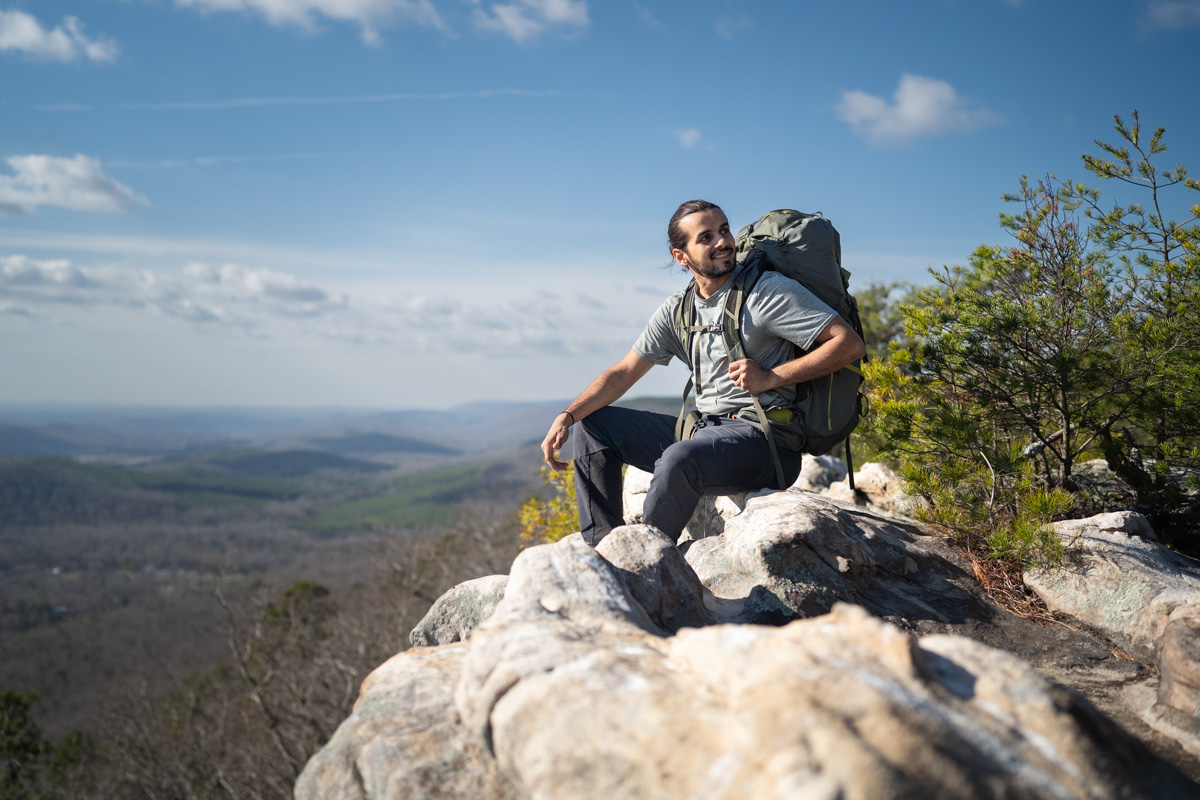

The days of hauling a massive external frame pack and hobbling out of the forest with sore shoulders are long gone. Today’s backpacking backpacks favor streamlined silhouettes, ergonomic builds, and smart, load-stabilizing features. From the lush, misty trails of the Pacific Northwest to the sunbaked plains of the African savannah, the Switchback Travel team has logged thousands of miles testing packs to pinpoint the standouts. Below are our favorite men’s backpacking backpacks of 2025, spanning everything from ultralight rigs for minimalists and thru-hikers to plush, supportive designs for weekend warriors and multi-day missions. For more background information, see our comparison table and buying advice below the picks, along with details about our testing process. Finally, while the options below highlight men's styles, check out our unisex round-up which covers both men's and women's designs. We've also put together a list of the best women's backpacking packs, as well as a round-up of the best ultralight backpacks.
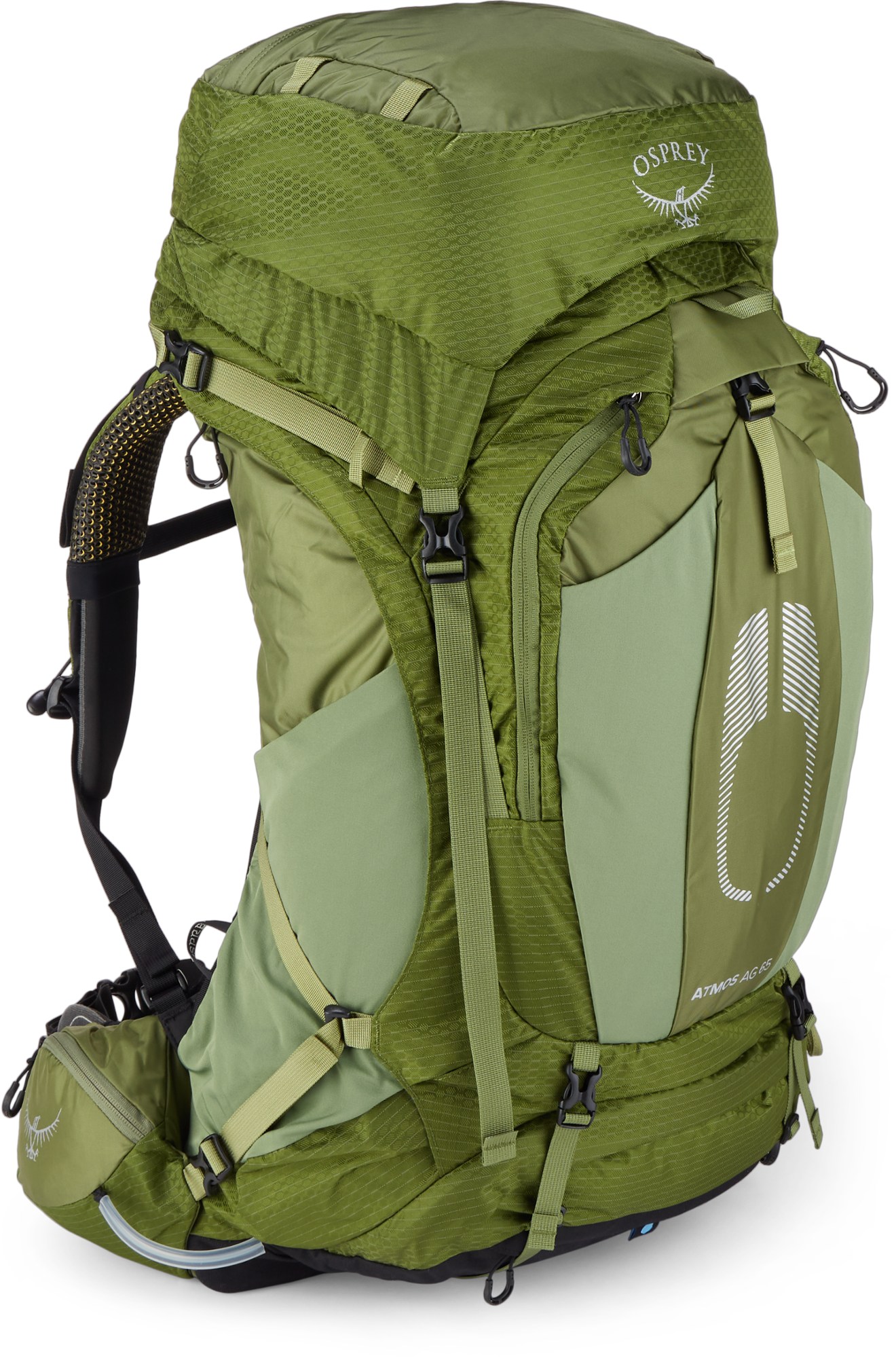 Weight: 4 lb. 9.8 oz.
Weight: 4 lb. 9.8 oz.
Fabric: Nylon (210D body, 500D bottom)
Capacities: 50, 65L
What we like: A standout all-rounder with especially great ventilation.
What we don’t: Pricey and fairly heavy at over 4.5 pounds.
The Osprey Atmos AG 65 stands out as one of the best all-around backpacking packs for men, combining top-tier comfort, smart organization, and rugged build quality. Its hallmark feature is the “Anti-Gravity” suspended mesh backpanel, which eliminates traditional foam padding in favor of a full-length tensioned mesh that delivers unmatched airflow and a body-hugging fit. Add in a well-thought-out pocket layout, Osprey’s easily adjustable Fit-on-the-Fly harness and hipbelt, and premium materials that can handle years of hard use, and you’ve got a pack ready for anything from short overnighters to extended backcountry expeditions.
Osprey refreshed the Atmos several years back with handy side zippers for quicker access to the main compartment, an adjustable torso length for a dialed-in fit, and an integrated rain cover. They also switched to more sustainable materials, including a PFAS-free DWR coating. The updates brought a slight weight change and a bump in price, but the combination of comfort, stability, and features keeps the Atmos at the top of the heap. For those who want similar performance in a lighter package, the Atmos AG LT 65 (4 lb. 1.0 oz.) trims a few extras while retaining an excellent fit and carrying ability.
Read more: Osprey Atmos AG 65 review
See the Osprey Atmos AG 65
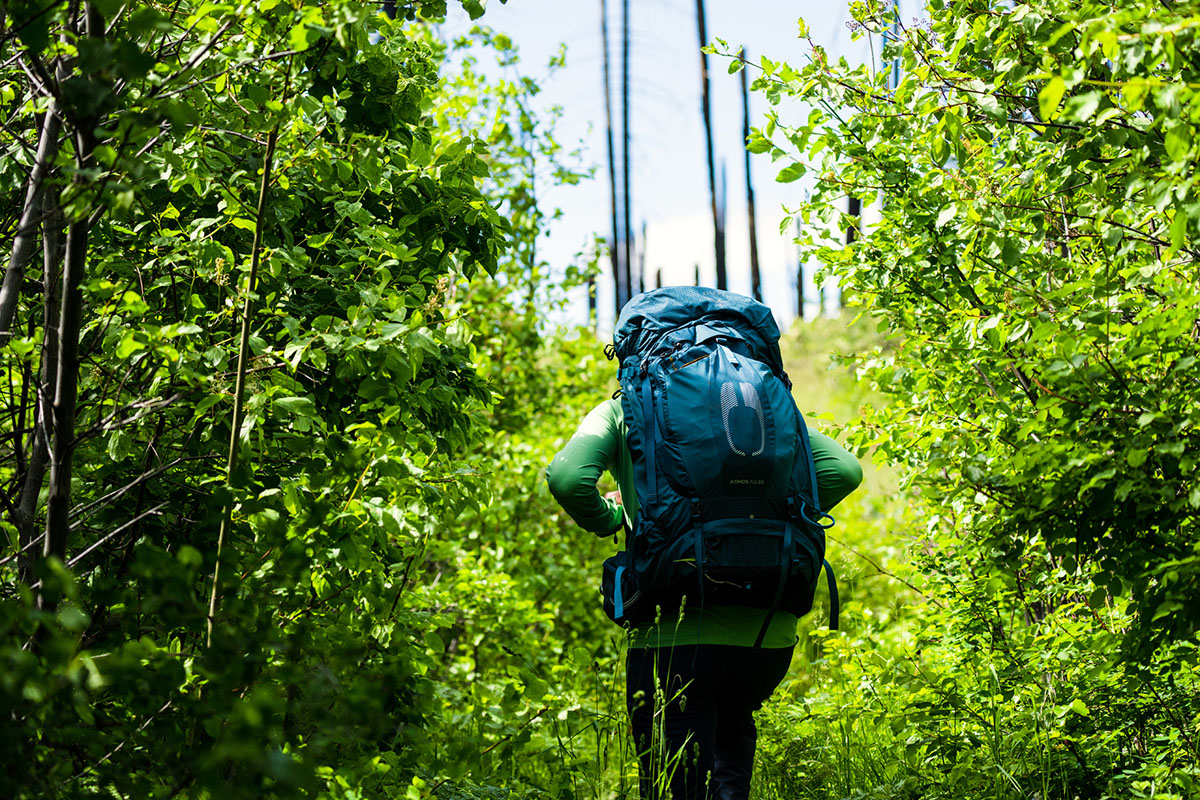
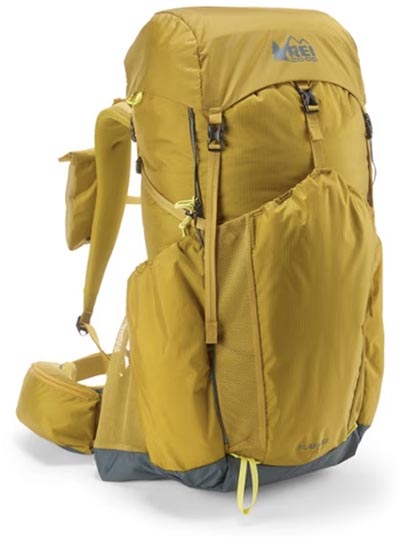 Weight: 2 lb. 13.0 oz.
Weight: 2 lb. 13.0 oz.
Fabric: Nylon
Capacity: 55L
What we like: Inexpensive, lightweight, and lots of customization options.
What we don’t: A step down in performance from the Exos below; shoulder strap pocket is prone to falling off.
For men seeking a capable backpacking pack without draining the wallet, REI’s Flash 55 hits a sweet spot. At under 3 pounds, it’s impressively light yet packed with thoughtful features: four tall side pockets for items like trekking poles or a tent, a roomy front dump pocket, daisy-chain attachment points, and an easy roll-top closure. One of its biggest draws is the modular “Packmod” system—compression straps, two hipbelt pockets, and a shoulder strap pocket can all be removed to trim up to 7 ounces. We’ve hauled the Flash everywhere from thorny bushwhacks in East Africa to multi-day trips in Wyoming’s Wind River Range, and it’s consistently struck a solid balance between weight savings, storage, and trail comfort.
That said, you do give up some performance compared to pricier models. Those packs breathe better thanks to suspended mesh backpanels and handle heavier loads with more stability. The Flash can manage up to 35 pounds without major complaint, but overall the frame and padding aren’t quite as confidence-inspiring. The included shoulder strap pocket is also more trouble than it’s worth—it tends to snag and fall off, so we ditched it early in testing. Still, if you’re a budget-minded backpacker who wants a light, customizable pack that can hold its own on a variety of trips, the Flash 55 is one of the best values out there.
Read more: REI Flash 55 review
See the REI Co-op Flash 55
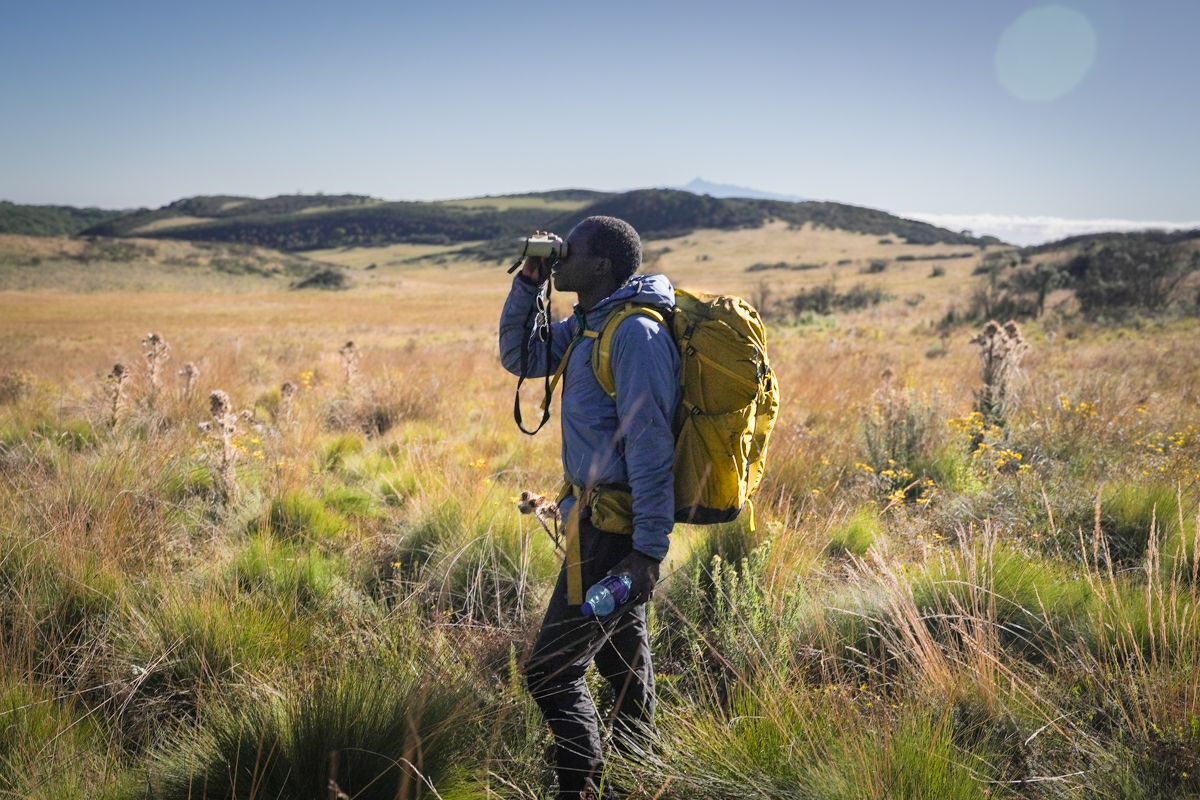
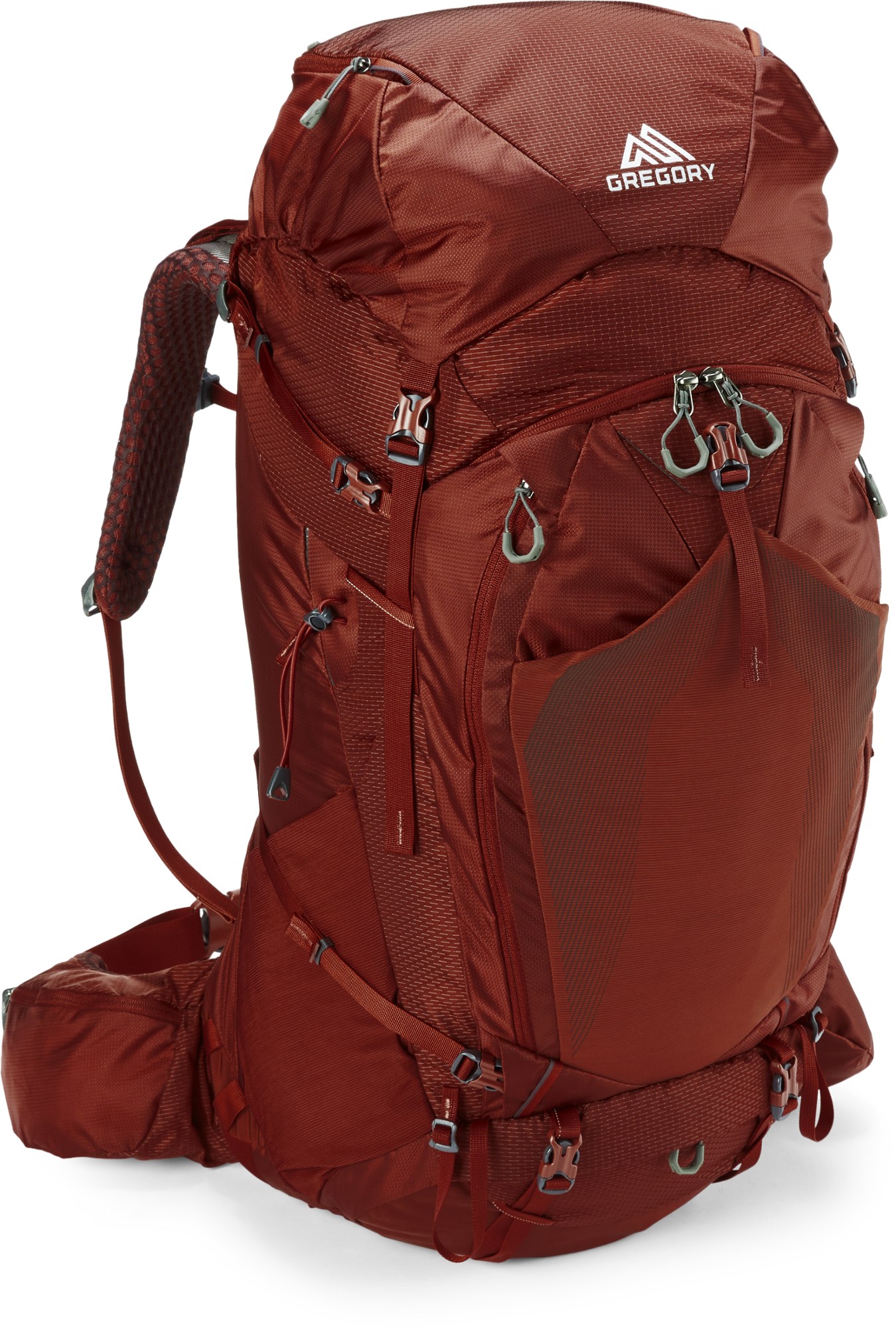 Weight: 4 lb. 15.7 oz.
Weight: 4 lb. 15.7 oz.
Fabric: Nylon (210D & 420D body, 630D bottom)
Capacities: 65, 75L
What we like: Heavy-hauling comfort with a great feature set.
What we don’t: Pretty hefty and overkill for weight-conscious backpackers.
The Gregory Baltoro 75 has long been a go-to for men who prioritize comfort and stability when hauling serious weight, and the latest version only sharpens that reputation. Built with a robust suspension, firm yet plush padding, and a well-ventilated mesh backpanel, it’s designed to keep you comfortable even when carrying 40 pounds or more. The hipbelt hugs securely, pivoting shoulder straps move naturally with your body, and organization is top-notch with nine external pockets, a large U-shaped front zipper to the main compartment, and oversized hipbelt pockets that easily fit today’s larger smartphones.
During testing in Patagonia, the Baltoro 75 proved itself as one of the most supportive and feature-rich packs on the market. Gregory also made the fit even more adjustable with customizable hipbelt and shoulder strap components, dropped the old Sidekick daypack (a worthwhile weight savings), and incorporated more recycled materials. The main tradeoff? This isn’t a lightweight option—at nearly 5 pounds, it’s about double the weight of an ultralight 70-liter pack like the Hyperlite Southwest below. For ounce-counters, that’s a dealbreaker. But if your trips demand carrying heavier, bulkier loads, the Baltoro 75 offers best-in-class comfort, stability, and storage—making that extra pound or two well worth it.
Read more: Gregory Baltoro 75 review
See the Gregory Baltoro 75
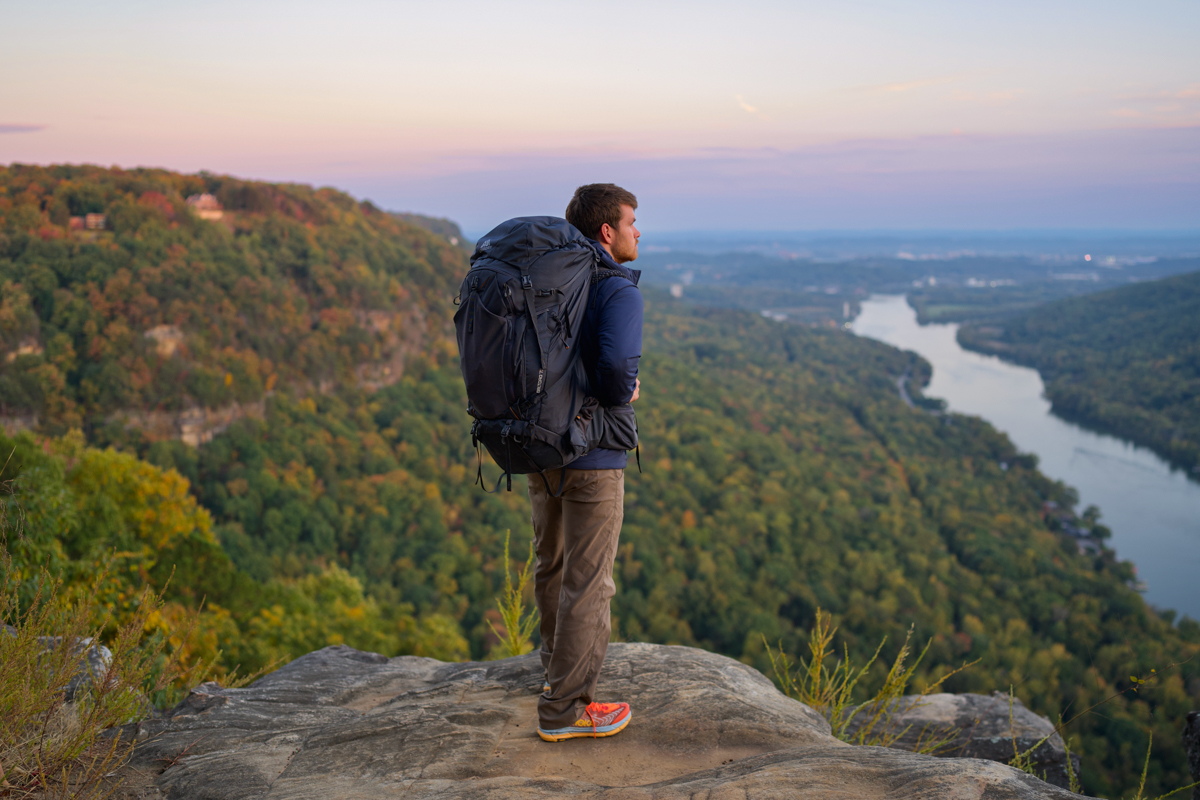
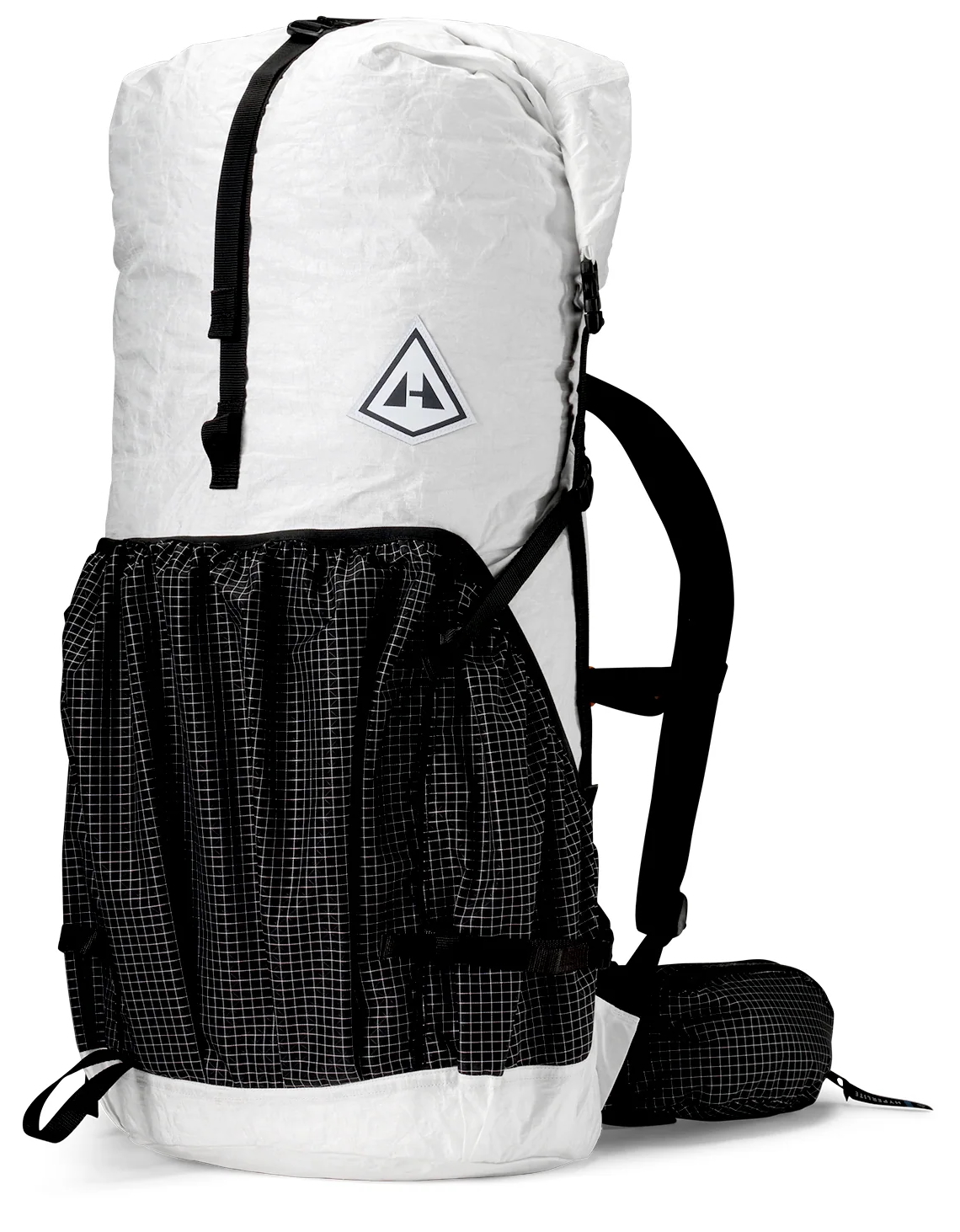 Weight: 1 lb. 13.7 oz.
Weight: 1 lb. 13.7 oz.
Fabric: Dyneema Woven Composite 3.9
Capacities: 40, 55, 70L
What we like: Impressively light but strong and can carry a full load.
What we don’t: Expensive and minimal organization.
Ultralight backpackers and thru-hikers have long praised the Hyperlite Mountain Gear Southwest 55, and for good reason. Its Dyneema Woven Composite fabric delivers exceptional strength and water resistance at an impressively low weight. Paired with a firm foam backpanel and aluminum stays, the Southwest carries heavy loads surprisingly well for its minimal weight—just 1 pound 13.7 ounces for the white 55-liter version. It’s no surprise this pack has become a staple on long-distance trails. Hyperlite also offers variations like the Windrider, which swaps the solid fabric for mesh pockets, perfect for drying gear on the go. With a 55-liter capacity (also available in 40 and 70L sizes), the Southwest is well-suited for extended backpacking trips and even packrafting expeditions, where it doubles as a durable dry bag.
The simple layout centers around a large main compartment and a handful of exterior pockets, keeping organization minimal but effective. Breathability is a downside, as the Dyneema-backed panel traps heat more than mesh-heavy designs. For those seeking a slightly lighter, more feature-packed alternative, Hyperlite’s Unbound 55 offers stretchy pockets, external daisy chains, and a removable hipbelt, though it sacrifices some stability with a single stay compared to the Southwest’s dual stays. Note: The Southwest has recently been updated and the current version now has a lighter but more durable fabric, redesigned shoulder straps and a sewn-through back panel to provide more comfort and security, and revamped outer pockets that are deeper but with a lower back edge to make grabbing things like a water bottle easier. We will be sure to update our review once we get more time with this latest iteration.
Read more: Hyperlite Mountain Gear Southwest 55 review
See the Hyperlite Mountain Gear Southwest 55
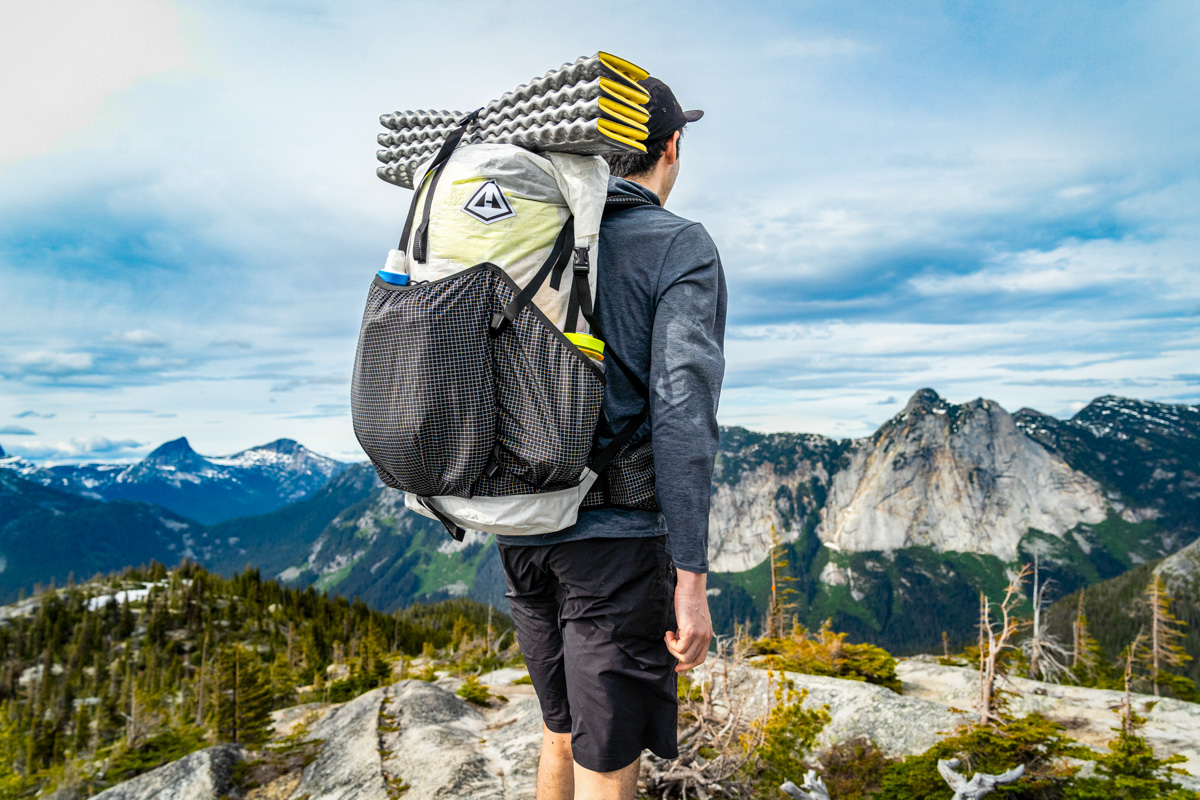
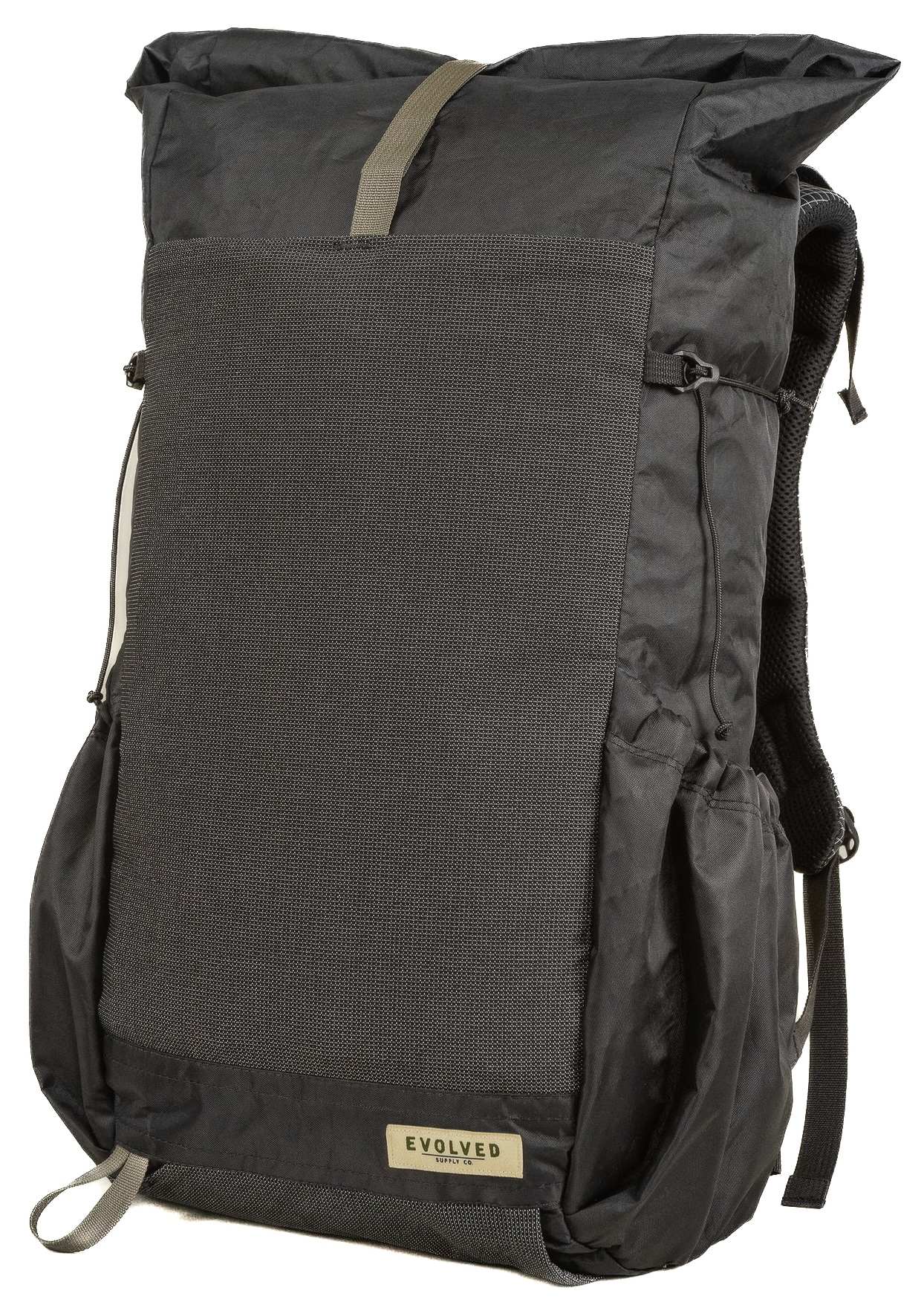 Weight: 1 lb. (stripped down), 1 lb. 5.0 oz. (complete pack)
Weight: 1 lb. (stripped down), 1 lb. 5.0 oz. (complete pack)
Fabric: Ecopak EPLX 200 & EPX200, Venom UL
Capacities: 40L (main compartment) + 11.8L (outside storage)
What we like: All the features we want in a UL pack in a streamlined, thoughtful design.
What we don’t: Spotty availability; small hipbelt clip.
Evolved Supply Co. may be new to the ultralight scene, but their debut pack—the Ranger—has already earned a loyal following. Founder Nic “Darwin” Rakestraw, a respected voice in the thru-hiking world and veteran gear designer, clearly poured his deep trail experience into this design. We’ve put the Ranger through its paces on trips ranging from quick overnighters in the Grand Canyon to multi-day treks in Wyoming's Wind River Range, and it’s proven impressively comfortable, durable, and weather-ready. The frame relies on one-piece U-shaped vertical bindings for stiffness, while minimizing horizontal seams (reinforced with Ultra TNT tape) to boost water resistance.
This attention to detail extends everywhere—from the reinforced shoulder strap attachments to the expandable 32-inch roll-top collar that takes the main compartment from 35 to 40 liters. The Ranger comes with a single top compression leash in its stripped-down form, while the complete kit adds a removable Y-strap for extra security. The removable hipbelt is padded and comfortable, though its lightweight clips can be tricky to close under tension and may raise long-term durability questions. The biggest hurdle is actually buying one—demand is high, and lead times can be long if it’s out of stock. Still, for ultralight trail trotters seeking a smaller ultralight pack that blends trail-ready toughness with refined design, the Ranger is one of the best options available. To see how it stacks up to the rest of the market, check out our dedicated round-up of the best ultralight backpacks.
See the Evolved Supply Co. Ranger
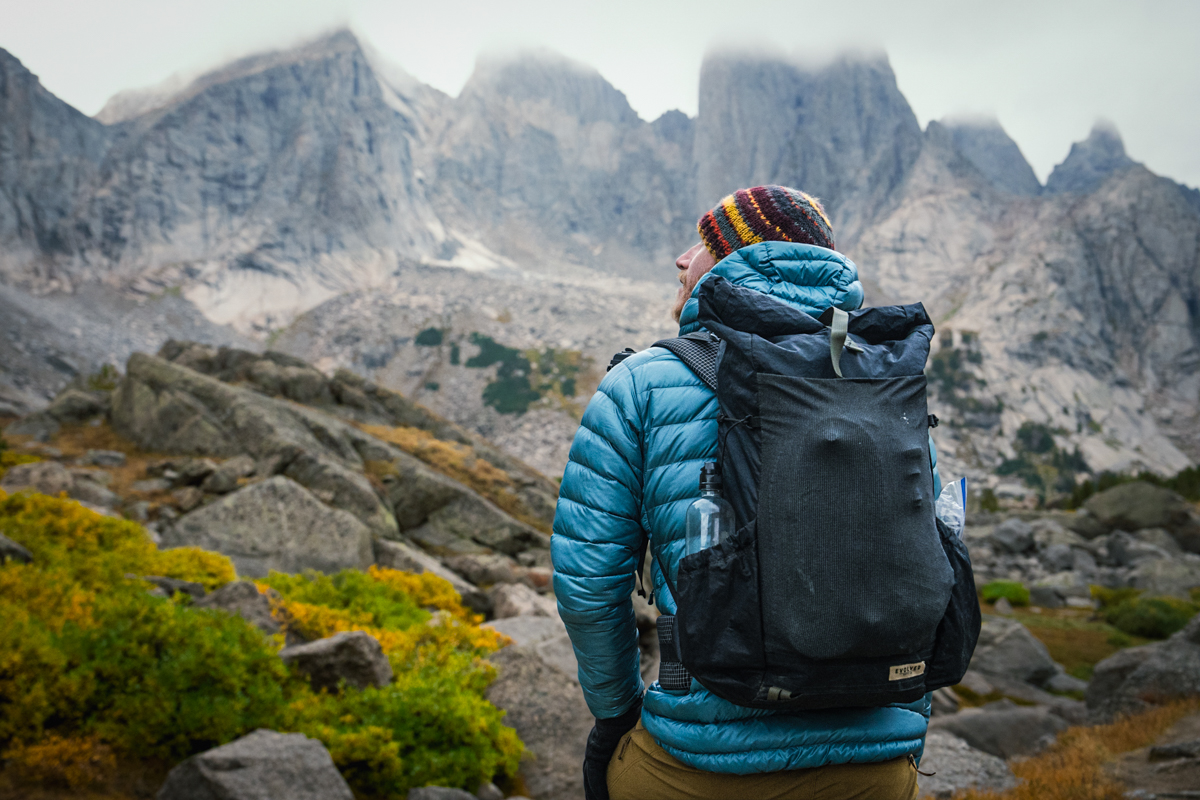
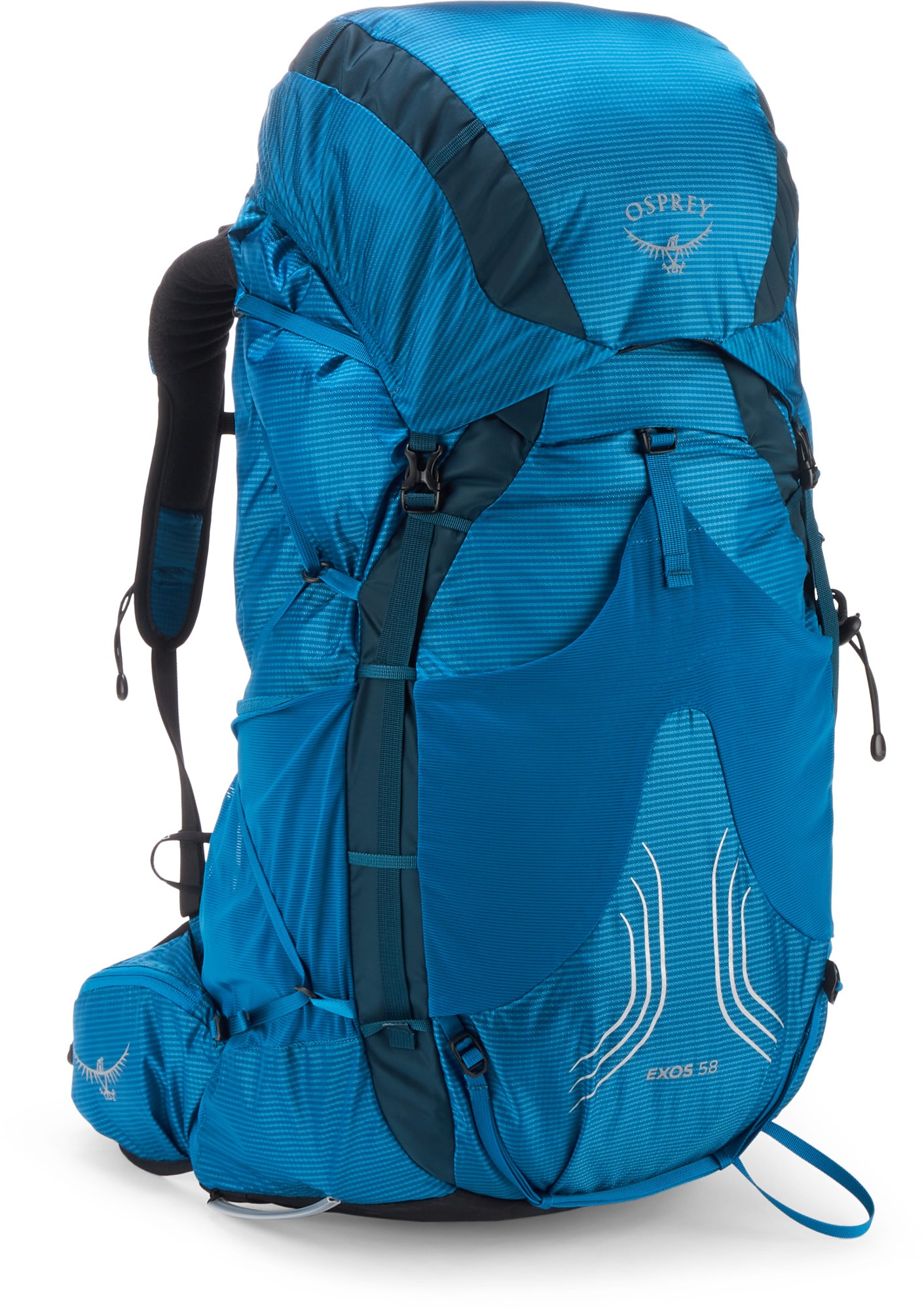 Weight: 2 lb. 13.4 oz.
Weight: 2 lb. 13.4 oz.
Fabric: Nylon (100D body, 100D bottom)
Capacities: 38, 48, 58L
What we like: Excellent mix of carrying comfort, ventilation, and build quality at a reasonable weight.
What we don’t: Relatively thin materials; overly complicated for many minimalists and thru-hikers.
If you're looking to bridge the gap between a traditional backpack and an ultralight design, the Osprey Exos 58 hits a sweet spot. First launched over a decade ago, the Exos has earned its reputation for blending comfort, ventilation, and thoughtful organization in a pack that still comes in under 3 pounds. While it’s heavier than stripped-down UL models like the Hyperlite Southwest above, that extra weight translates to a sturdier suspension, a plush backpanel, and a few convenience features, like an adjustable torso length and hipbelt pockets (reintroduced in the latest update), that make it more user-friendly for those new to the ultralight world.
On the trail, the Exos offers impressive load stability and airflow thanks to its tensioned mesh backpanel, making it a great option for warm-weather trips or heavy-mile days. The 100D nylon body and base aren’t as tough as Dyneema or higher-denier fabrics, but they’ve proven surprisingly durable through extended testing. Against its closest rival, the Gregory Focal, the Exos wins on comfort and adjustability, though it’s not quite as simple or minimalist. If you're seeking an even lighter, more streamlined Osprey build, the Exos Pro 55 trims the weight to just over 2 pounds—ideal for thru-hikers ready to fully commit to ultralight efficiency.
Read more: Osprey Exos 58 review
See the Osprey Exos 58
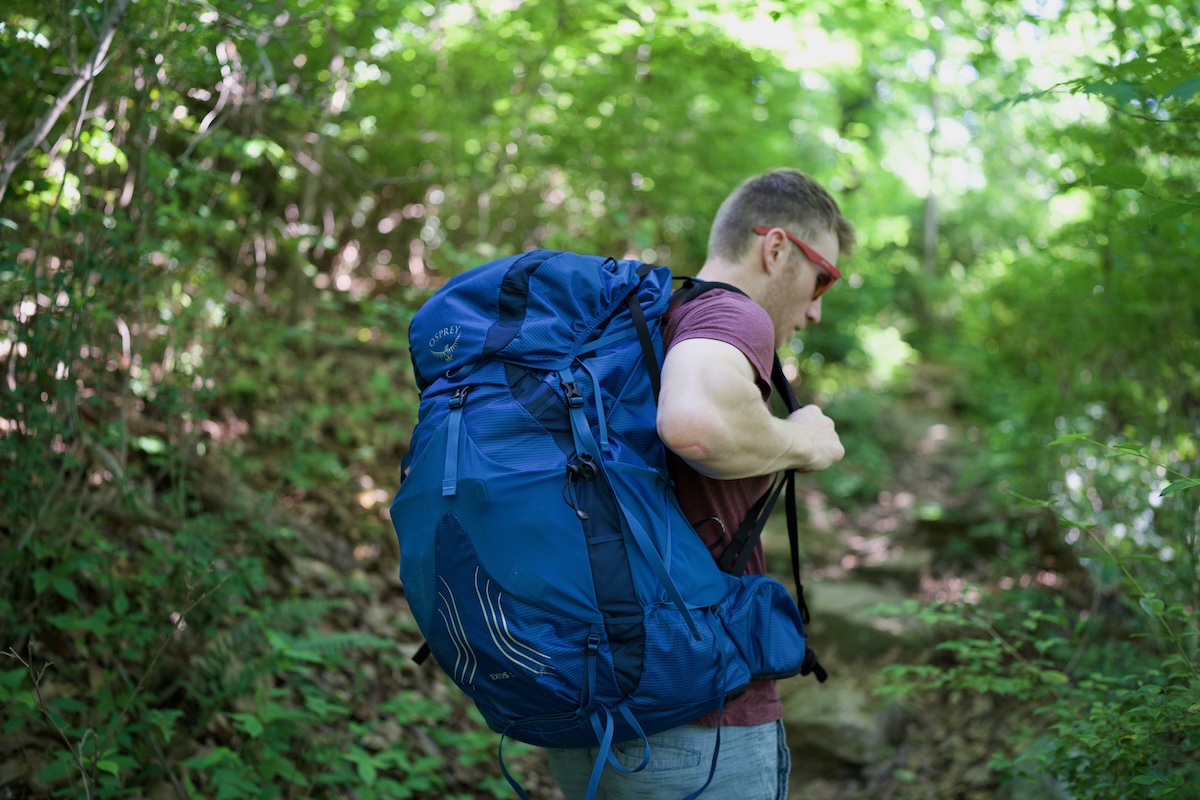
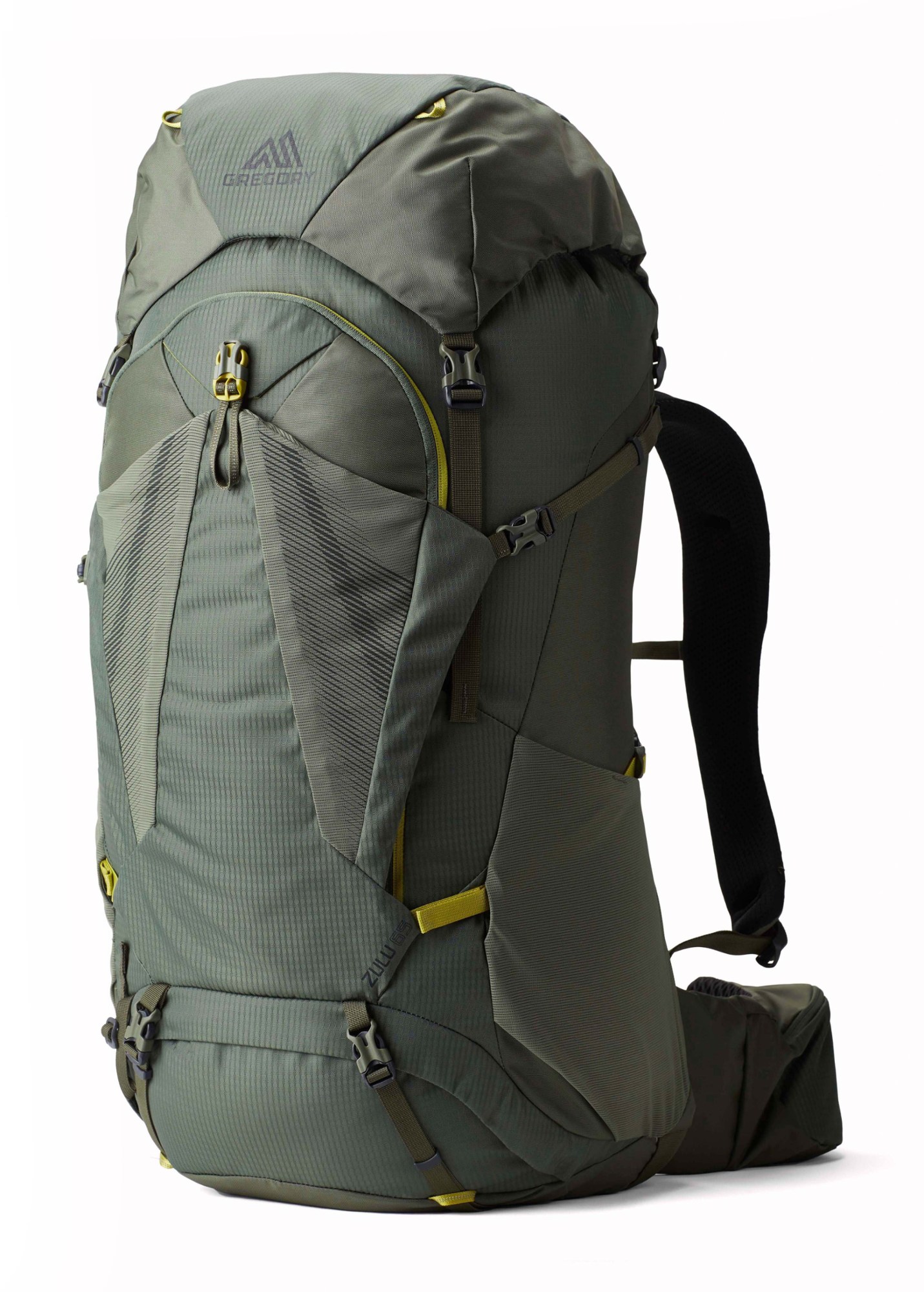 Weight: 4 lb. 7.4 oz.
Weight: 4 lb. 7.4 oz.
Fabric: Polyester (400D body, 420D bottom)
Capacity: 65L
What we like: Thoughtful and well-rounded design built specifically for plus-size backpackers.
What we don’t: Only offered in one capacity and colorway.
For too long, plus-size backpackers had to make do with ill-fitting packs—or skip the activity altogether. Gregory was one of the first major brands to address this gap, introducing plus-size versions of some of their most popular models. The Zulu 65 Plus Size is a standout in the men’s lineup, with wider and longer shoulder straps, an extended hipbelt that fits waists from 39 to 60 inches, and repositioned load lifters and hipbelt pockets for easier reach. Compared to the straight-size Zulu (which fits 27–53 inches), the Plus Size version is comparable to men’s apparel sizing from 2X to 6X, offering a much-needed fit option for a wider range of hikers.
The Zulu is a great choice for those who want comfort and durability without jumping into a heavy-duty expedition pack. Its plush padding and dynamic suspension move naturally with the body, keeping things stable over uneven ground, while tough fabrics stand up well to regular use. Multiple access points—top, front, and bottom—make it easy to organize and find gear, and there’s no shortage of pockets for stashing essentials. Ventilation and weather resistance could be better, but for most backpackers, the Zulu 65 Plus Size nails the balance between support, features, and value.
See the Gregory Zulu 65 Plus Size
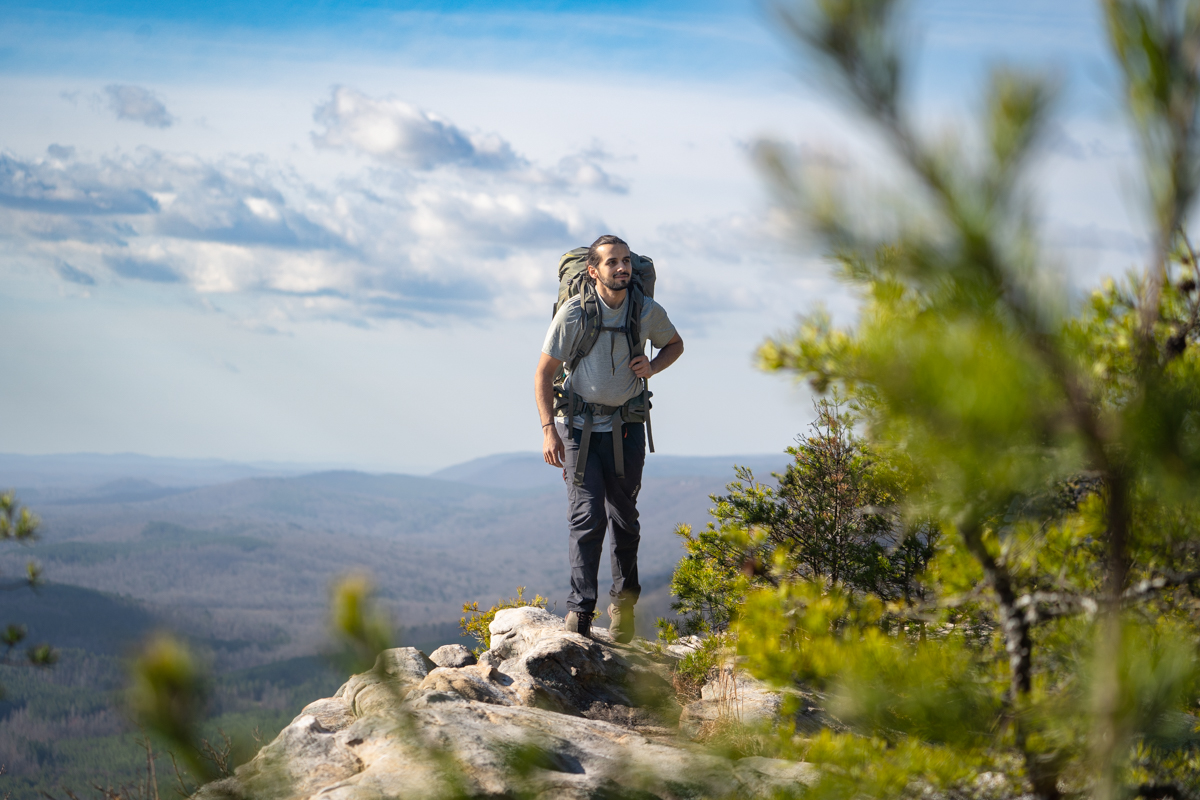
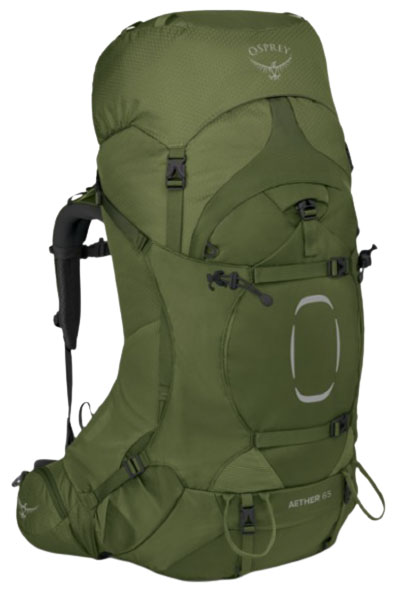 Weight: 4 lb. 14.7 oz.
Weight: 4 lb. 14.7 oz.
Fabric: Nylon (420D body, 420D bottom)
Capacities: 55, 65L
What we like: Great adjustability and very comfortable for hauling heavy loads.
What we don’t: Heavy; most backpackers are better off with the Atmos above.
While the Atmos AG is Osprey’s top recommendation for all-around backpacking, the Aether steps it up for heavier loads and light mountaineering. The latest model swapped out the Anti-Gravity suspension for an AirScape backpanel, which isn’t as complex but still uses breathable foam and mesh to keep you cooler on the trail. Fit adjustments are plentiful, thanks to a rip-and-stick system that fine-tunes the shoulder straps and hipbelt. You also get multiple compression straps and attachment points designed for gear like ice axes and tent poles. Plus, a large J-shaped front zipper lets you easily reach the main compartment without unloading the pack.
That said, the Aether 65’s biggest drawback is its weight, clocking in just under five pounds. Organization-wise, it feels a bit sparse, with only five external pockets (seven if you include water bottle holders), and the hipbelt pockets are awkwardly placed and hard to access. For many hikers, the lighter Atmos AG offers a better overall balance at about half a pound less, and the Gregory Baltoro 75 provides more capacity for a similar weight. Still, for those carrying heavy loads who want a rugged, durable pack, the Aether holds strong. Osprey also offers the beefier Aether Plus and the pared-down Aether Pro, so there’s a solid range depending on what you need.
Read more: Osprey Aether 65 review
See the Osprey Aether 65
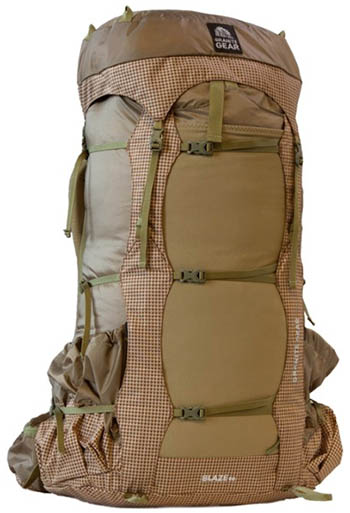 Weight: 3 lb. 0 oz.
Weight: 3 lb. 0 oz.
Fabric: Robic nylon (100D & 210D)
Capacity: 60L
What we like: Excellent mix of carrying comfort, organization, and weight.
What we don’t: Durability and back ventilation can’t match the Atmos AG above.
Granite Gear’s Blaze 60 stands out as their flagship for serious hauling, offering solid load-carrying ability and practical features while tipping the scales at just 3 pounds. We originally tested it on a difficult trek through the Grand Canyon and came away impressed. The sturdy internal frame sheet paired with generous padding on the hipbelt and shoulder straps made carrying a full load—rated for up to 50 pounds—feel stable and comfortable. Accessing gear was simple thanks to a zippered main compartment opening, and the oversized front and side pockets are highly functional—you can easily fit two standard water bottles in a single side pocket. Even better, the Blaze manages to do all this while coming in a pound or more lighter than many competitors.
On the downside, the padded backpanel favors comfort and support over airflow, making it stiffer and warmer compared to mesh-heavy packs like the Osprey Atmos above. Adjusting the fit takes some getting used to, particularly when removing and replacing the shoulder strap clips behind the frame sheet, which felt fiddly and frustrating at times. These are minor complaints, though, and overall the Blaze 60’s balanced design and solid performance earn it a spot among our favorite heavy-hauling packs.
Read more: Granite Gear Blaze 60 review (women's version)
See the Men's Granite Gear Blaze 60
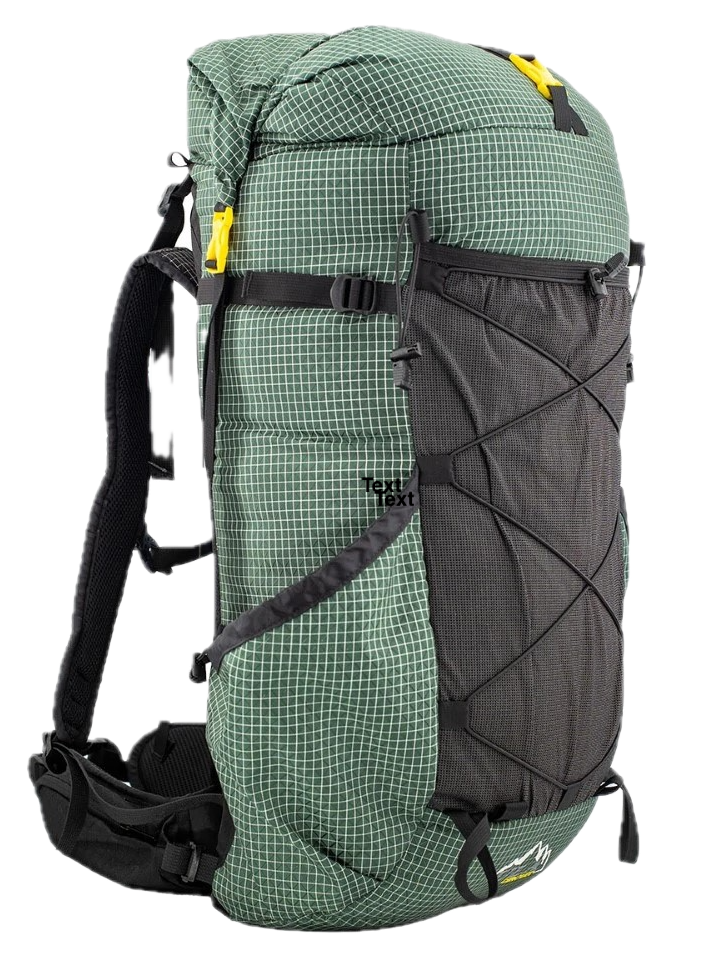 Weight: 2 lb. 9.0 oz.
Weight: 2 lb. 9.0 oz.
Fabric: Robic nylon (400D body, 400D bottom)
Capacity: 68L
What we like: A thru-hiker favorite with functional organization, good comfort, and solid durability at a good price.
What we don’t: Not as water-resistant as a Dyneema pack.
Utah-based ULA Equipment has quickly become a favorite among Pacific Crest Trail and Appalachian Trail hikers, thanks in large part to their 68-liter Circuit. This pack strikes a smart balance between rugged durability, minimalist design, and practical features—making it ideal for thru-hikers and anyone carrying lighter loads (under 30 pounds). The layout keeps things simple but functional, with a huge front mesh pocket, zippered hipbelt compartments, an internal stash pocket, and generous side water bottle holders made from the same tough fabric as the body. We’ve tested the Circuit on multi-day treks in Patagonia and climbs up Colorado’s 14ers, and it impressed us with how easy it is to pack, adjust, and even convert into a streamlined daypack when needed.
While the Circuit doesn’t use Dyneema like some top-shelf ultralight packs, its 400D Robic nylon is impressively abrasion-resistant and less prone to punctures than many Dyneema options we’ve seen. The carbon fiber suspension, aluminum stay, and rigid foam backpanel provide solid support that helps maximize the roomy 68-liter capacity. Plus, the pack comes in a wide range of sizes, with customizable torso lengths, hipbelt sizes, and shoulder strap options to dial in your fit. If you’re willing to trade a bit of Dyneema’s water resistance, weight savings, and name recognition, the ULA Circuit delivers a compelling mix of durability, comfort, and value.
See the ULA Equipment Circuit 68
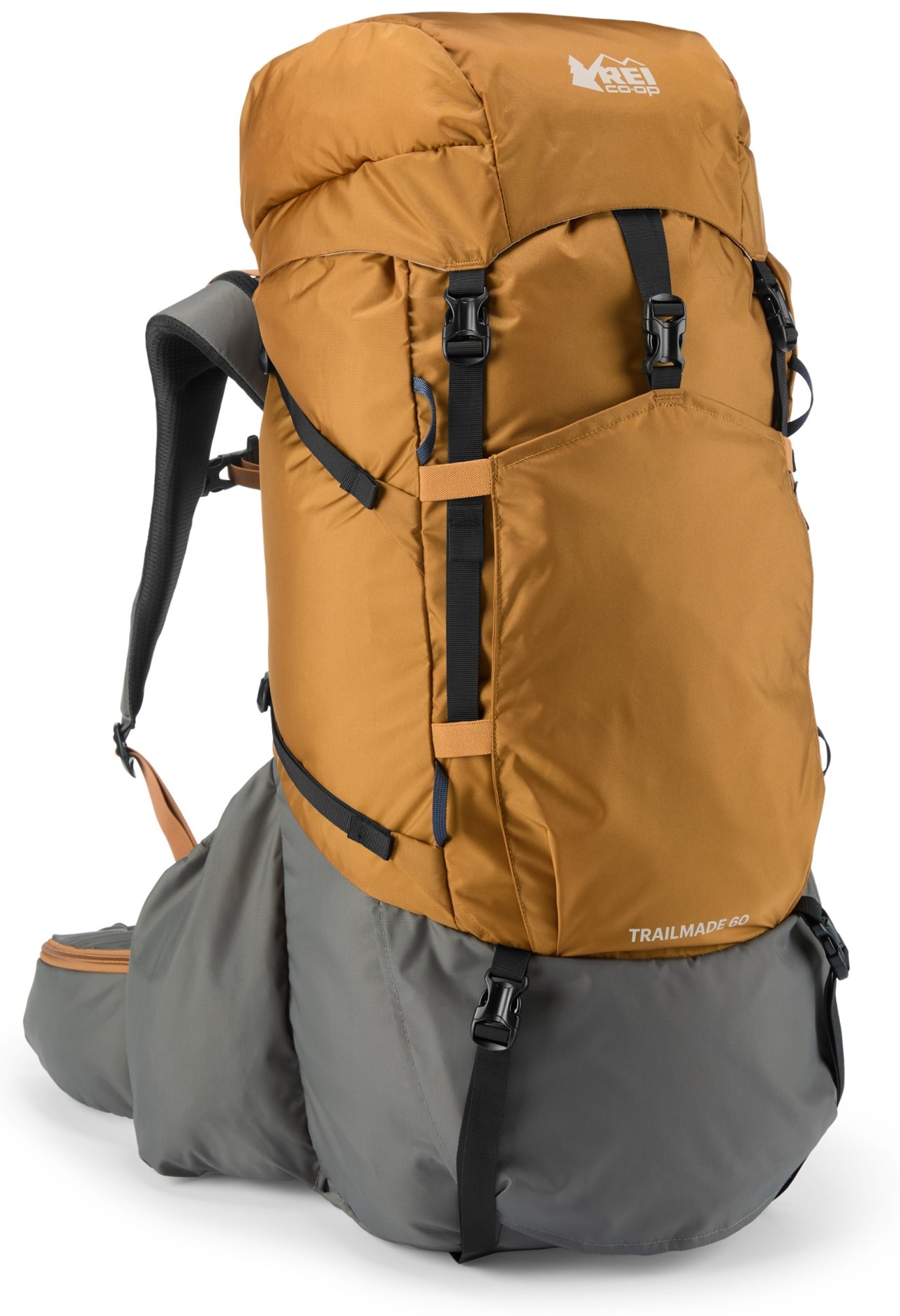 Weight: 3 lb. 6.0 oz.
Weight: 3 lb. 6.0 oz.
Fabric: Nylon
Capacity: 60L
What we like: Decent performance for the price; sizing is very adjustable.
What we don’t: Cheaper materials and budget-feeling fit and finish.
If you’re new to backpacking or just looking for a solid budget-friendly option, REI’s in-house Trailmade 60 is a smart place to start. It’s not the flashiest pack around—in fact, it has a bit of a '90s-era vibe—but it handles multi-day trips with up to 40 pounds comfortably. The spacious main compartment, dedicated sleeping bag pocket, and six external pockets offer plenty of organization for the price. At $179, it’s a strong value pick for casual backpackers or those who only get out a few times a year.
That said, there are trade-offs compared to pricier models. The materials feel cheaper and soak up moisture quickly, while the backpanel lacks breathable mesh, which limits ventilation. The hipbelt pockets are too small for most smartphones, and the foam padding on the hipbelt, shoulder straps, and back may compress over time. The one-size-fits-most torso adjustment and limited hipbelt sizing mean it won’t offer the tailored fit of multi-size packs, though this also makes it easier to share. Overall, for a straightforward, no-frills pack that gets the basics right, the Trailmade 60 stands out as another great budget backpack.
Read more: REI Co-op Trailmade 60 review (women's version)
See the Men's REI Co-op Trailmade 60
 Weight: 3 lb. 8.3 oz.
Weight: 3 lb. 8.3 oz.
Fabric: Nylon (100D & 210D body, 300D bottom)
Capacities: 50, 60, 70L
What we like: A well-balanced design with a useful feature set.
What we don’t: Heavier but no more comfortable than the Blaze above.
Gregory’s Baltoro sets the premium standard (especially for hauling a heavier load), but if you’re after something lighter and more budget-friendly, the Paragon 60 is a compelling alternative. Weighing in at 3 pounds 8.3 ounces, it’s well-suited for smaller loads and comes in 50, 60, and 70-liter sizes. While it doesn’t match the Baltoro’s plush padding or extensive organization, the Paragon delivers solid fit adjustments, plenty of breathable mesh on the backpanel, and durable construction with quality zippers and supportive foam. It also includes handy features like a large mesh front pocket, dual access to the main compartment via top and full-length side zippers, a zippered sleeping bag compartment, and a bear canister-friendly shape.
Striking a balance between minimalist ultralight packs and heavier, comfort-focused haulers, the Paragon directly competes with the Osprey Atmos above. Gregory’s pack has the advantage on price and weight—over a pound lighter—but the Atmos still leads when it comes to comfort, ventilation, and external storage options. The Atmos also boasts a more premium build with thicker, more durable fabrics. If ventilation is a priority, Gregory’s Zulu 65 (above) is worth a look, though we found it slightly lacking in carrying comfort.
Read more: Gregory Paragon 58 review (prior version)
See the Gregory Paragon 60
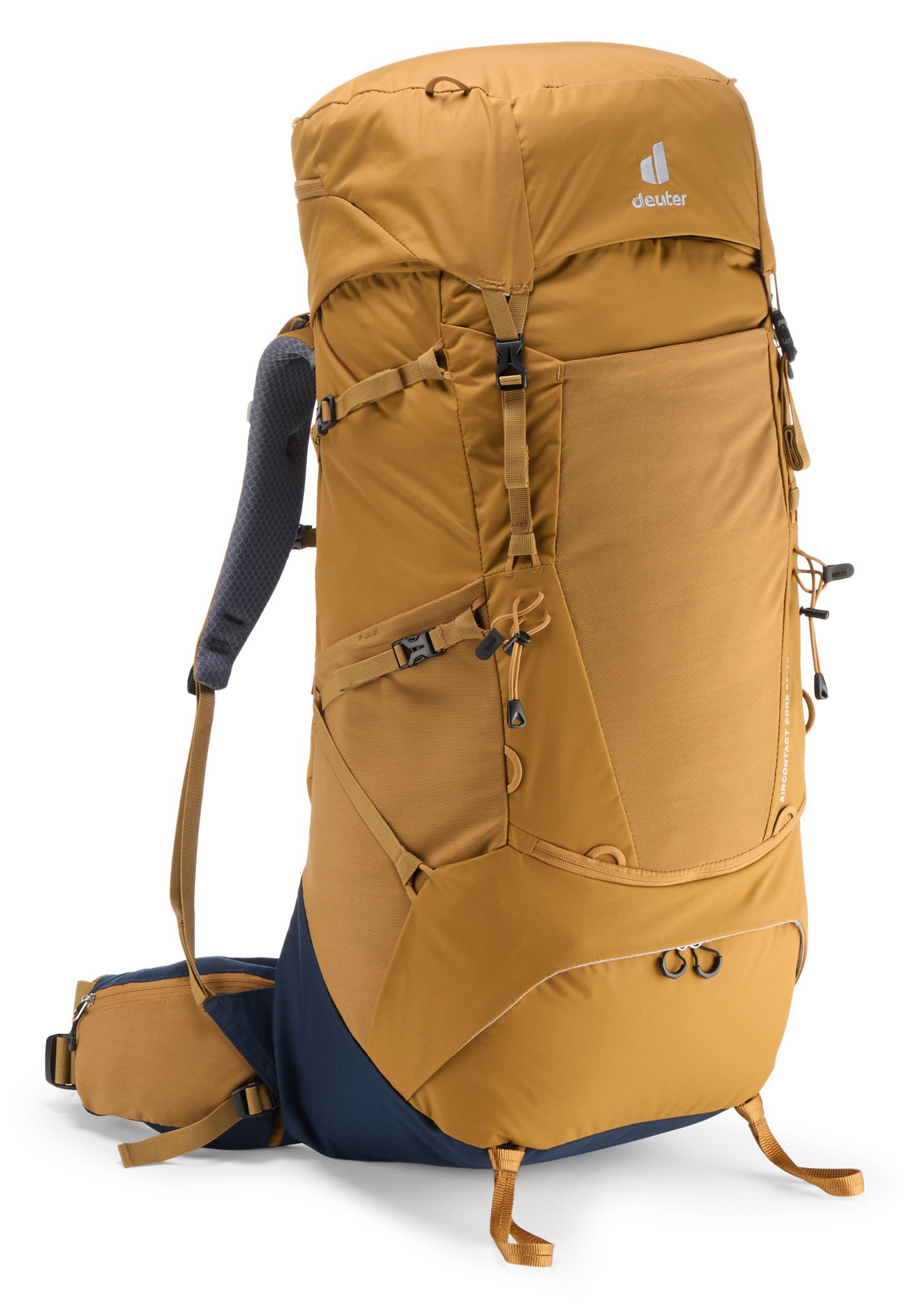 Weight: 5 lb. 2.6 oz.
Weight: 5 lb. 2.6 oz.
Fabric: Polyamide (235D body, 500D bottom)
Capacities: 45, 60L
What we like: Great comfort and organization for significantly less than a lot of the competition.
What we don’t: Only available in one size; limited load carrying despite being the heaviest pack here.
German brand Deuter has been crafting quality backpacks since the early 1900s, and their current lineup competes well with premium names like Osprey and Gregory. The Aircontact Core is their versatile all-rounder, focusing on comfort and organization for multi-day trips. Much like the Osprey Aether and Gregory Baltoro, it features a solid suspension system, adjustable torso length, and ample storage including dual hipbelt pockets, lid compartments, and a convenient J-shaped front zipper. We tested the Aircontact Core 60 + 10 SL in Washington’s Glacier Peak Wilderness and came away impressed with its comfort and practical layout during long days on trail.
The Aircontact Core offers excellent value for those who want a quality pack without dropping $300 or more, but it falls a bit short of the Osprey and Gregory heavy hitters. Weighing in similarly to those packs, it has a lower load limit of 44 pounds compared to their 55- to 60-pound capacities. Another drawback is the single size option, which means less of a tailored fit overall. Still, if you’re looking to try something beyond the usual crowd and save some money, the Aircontact is worth a serious look. Plus, Deuter’s lifetime repair policy is a standout — they’ll fix any pack for free, no matter the damage or age.
See the Aircontact Core 65 + 10
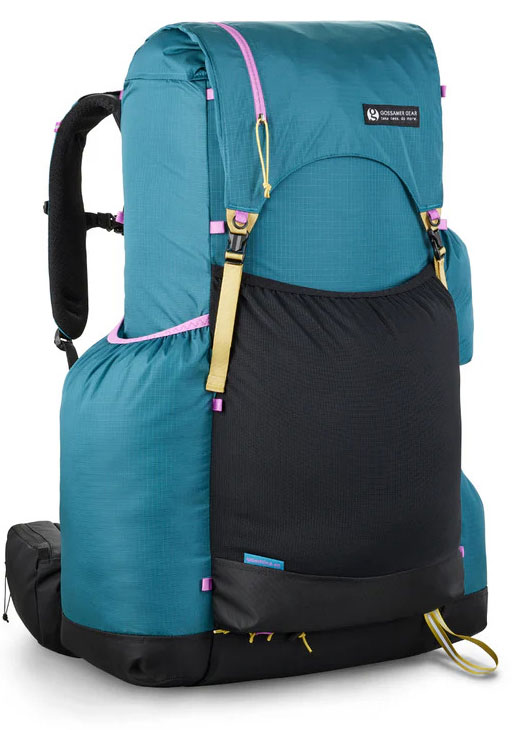 Weight: 2 lb. 2.2 oz.
Weight: 2 lb. 2.2 oz.
Fabric: Robic nylon (100D & 210D)
Capacity: 60L
What we like: Superlight with great organization and customization.
What we don’t: Doesn't do well being overloaded.
The Gossamer Gear Mariposa has been a longtime favorite among thru-hikers, and it’s easy to see why. Weighing just 2 pounds 2.2 ounces (medium size with a medium hipbelt), this pack strikes an impressive balance with very few compromises. It boasts seven external pockets—more than competitors like the Hyperlite and ULA. Equipment—making it simple to organize and access your gear on the go. Unlike Dyneema-heavy brands such as Hyperlite and Zpacks, the Mariposa uses durable Robic nylon (similar to ULA’s but a bit lighter), which helps keep costs down and stands up well to punctures. The trade-off is you’ll want to add a pack cover or dry bags for waterproofing. On top of that, Gossamer Gear offers excellent customization options: three pack sizes and separately sold hipbelts let you dial in the perfect fit.
In terms of comfort, the Mariposa delivers solid padding and support for loads up to its 35-pound max. Push beyond that, though, and the pack can feel unbalanced, which affects comfort and weight distribution. One notable improvement in the latest update is the backpanel—removable foam padding no longer bunches as it did before. The pack rides a bit lower and wider than some rivals like the HMG Southwest, which has a sleeker, torpedo shape. While that might not be everyone’s favorite look, the Mariposa’s shape works well for carrying bulkier gear like bear canisters. Overall, there’s plenty of strong competition in the ultralight pack world, but the Mariposa remains a top choice—especially for hikers who value smart organization.
Read more: Gossamer Gear Mariposa 60 review (prior version)
See the Gossamer Gear Mariposa 60
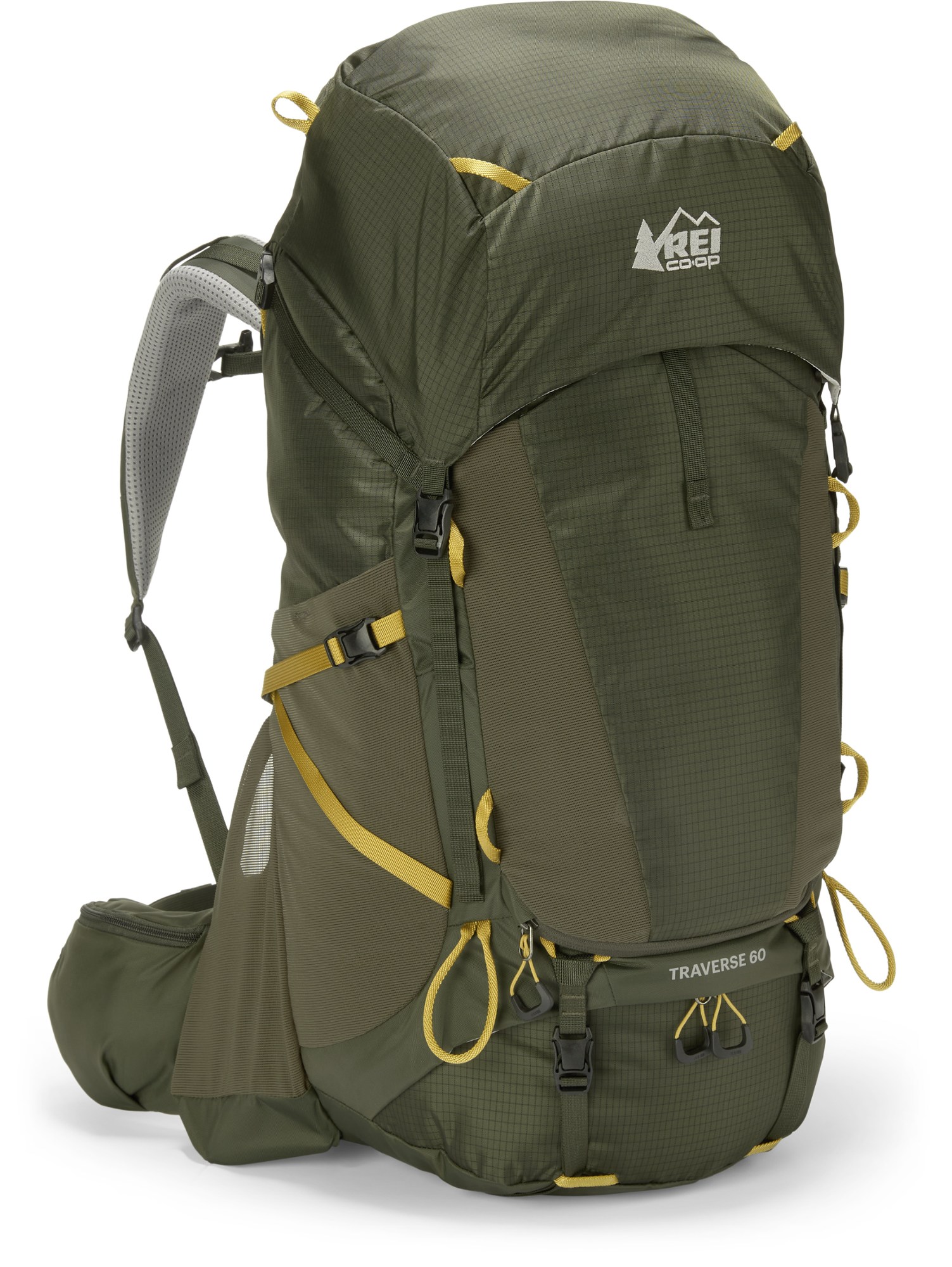 Weight: 4 lb. 10.0 oz.
Weight: 4 lb. 10.0 oz.
Fabric: Nylon (210D & 400D body)
Capacities: 35, 60L
What we like: Lid doubles as a daypack on short hikes from camp; REI improved access with the latest update.
What we don’t: Heavier than the prior version and still relatively dated-feeling.
Rounding out our REI picks for the season is the Traverse 60, which strikes a solid middle ground between the budget-friendly Trailmade and the lighter Flash 55 above. Like its siblings, the Traverse delivers strong value for the price, boasting some standout features: a top lid that quickly converts into a detachable daypack, large zippered hipbelt pockets for easy access, and dedicated attachments for trekking poles and ice axes. REI also addressed a major complaint from the previous model with the addition of a J-shaped zipper on one side, making main compartment access much easier. Plus, the pack now comes in four sizes for men and women, covering a wide range of torso and waist measurements.
So why is the Traverse 60 so low on our list? While it remains a solid value, the pack lost its rain cover in the latest update and gained some weight. REI also discontinued the Packmod system, removing the ability to customize external organization. Most importantly, the Traverse still feels budget-grade overall, with less ventilation and carrying comfort than more modern designs. This isn’t the pack you want to load up heavily, unlike higher-end models like the Baltoro or Aether. In sum, the Traverse 60 isn’t our top pick for serious backpackers who spend a lot of time on trail, but it’s a capable, affordable choice for beginners and more casual users.
Read more: REI Traverse 60 review (prior version)
See the REI Co-op Traverse 60
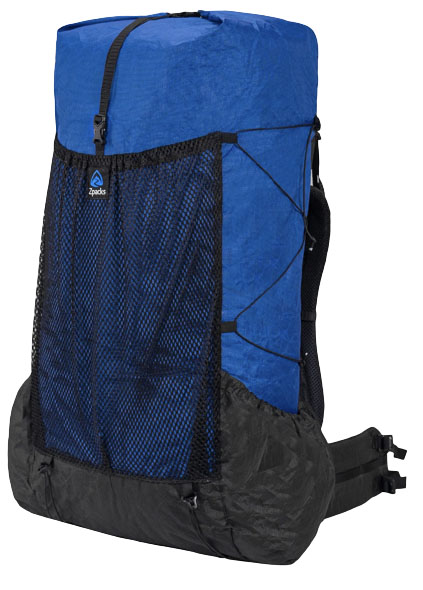 Weight: 1 lb. 5.4 oz.
Weight: 1 lb. 5.4 oz.
Fabric: Ultra (100D)
Capacity: 40, 50, 60, 70L
What we like: Incredibly lightweight, ventilated, and water-resistant.
What we don’t: Not very durable, expensive, and doesn’t carry loads as well as the other UL packs here.
Tipping the scales at just 1 pound 5.4 ounces for the 60-liter version, the Zpacks Arc Haul Ultra is impressively lightweight, coming in at least half a pound lighter than every other pack on our list except the Evolved Ranger above. You can tack on modular add-ons like shoulder and belt pockets or a water bottle holder to complete your setup, and the 100D Ultra fabric is a laminated woven UHMWPE (Ultra High Molecular Weight Polyethylene) that offers excellent waterproofing without adding weight. While we found the Arc Haul Ultra less durable than the Hyperlite Southwest—our pack suffered a small puncture on rocky terrain—repairs are straightforward, and the weight savings will be well worth it for dedicated thru-hikers and strict ounce-counters.
The pack’s signature “Arc” design uses a unique tensioning system that pulls the bag away from your back to improve airflow and eliminate the need for a foam backpanel, addressing Dyneema’s typical breathability issues. Built around a carbon fiber frame, the Arc Haul Ultra holds its shape well and supports loads up to around 30 pounds comfortably. That said, the complex web of straps, buckles, and add-ons introduces durability concerns over time—especially compared to the simpler Hyperlite design above. For casual weekend warriors, this pack might feel a little fragile or finicky, but for those who treat their gear with care and are after one of the lightest designs out there, it’s a fantastic ultralight option for long-distance and minimalist backpacking.
Read more: Zpacks Arc Haul Ultra 60 review
See the Zpacks Arc Haul Ultra 60L
| Pack | Price | Weight | Fabric (body) | Capacities | Access | Pockets |
|---|---|---|---|---|---|---|
| Osprey Atmos AG 65 | $370 | 4 lb. 9.8 oz. | Nylon (210D) | 50, 65L | Top, sides | 8 exterior |
| REI Co-op Flash 55 | $199 | 2 lb. 13.0 oz. | Nylon | 55L | Top | 9 exterior |
| Gregory Baltoro 75 | $380 | 4 lb. 15.7 oz. | Nylon (210D & 420D) | 65, 75L | Top, front | 9 exterior |
| Hyperlite Southwest 55 | $399 | 1 lb. 13.7 oz. | Dyneema Woven | 40, 55, 70L | Top | 5 exterior |
| Evolved Supply Co. Ranger | $260 | 1 lb. 5.0 oz. | EPLX 200 & EPX200 | 40L | Top | 4 exterior |
| Osprey Exos 58 | $280 | 2 lb. 13.4 oz. | Nylon (100D) | 38, 48, 58L | Top | 6 exterior |
| Gregory Zulu 65 Plus Size | $280 | 4 lb. 7.4 oz. | Polyester (400D) | 65L | Top, front | 7 exterior |
| Osprey Aether 65 | $345 | 4 lb. 14.7 oz. | Nylon (420D) | 55, 65L | Top, front | 7 exterior |
| Granite Gear Blaze 60 | $300 | 3 lb. 0 oz. | Robic (100D & 210D) | 60L | Top, side | 6 exterior |
| ULA Equipment Circuit 68 | $300 | 2 lb. 9.0 oz. | Robic nylon (400D) | 68L | Top | 5 exterior |
| REI Co-op Trailmade 60 | $179 | 3 lb. 6.0 oz. | Nylon | 60L | Top | 6 exterior |
| Gregory Paragon 60 | $300 | 3 lb. 8.3 oz. | Nylon (100D & 210D) | 50, 60, 70L | Top, side | 7 exterior |
| Deuter Aircontact Core 65 | $260 | 5 lb. 2.6 oz. | Polyamide | 50+, 65+L | Top, front | 6 exterior |
| Gossamer Gear Mariposa | $315 | 2 lb. 2.2 oz. | Robic (100D & 210D) | 60L | Top | 7 exterior |
| REI Co-op Traverse 60 | $249 | 4 lb. 10.1 oz. | Nylon (210D & 400D) | 35, 60L | Top, side | 9 exterior |
| Zpacks Arc Haul Ultra 60L | $399 | 1 lb. 5.4 oz. | Ultra (100D) | 40, 50, 60, 70L | Top | 3 exterior |
From gear-heavy technical trips to epic, months-long thru-hikes, the Switchback Travel team has logged countless miles testing a wide range of backpacks to hone in on the 16 standout models you see here. Senior editor Chris Carter curated this round-up in 2025. He has been hitting gear shows, picking the brains of industry experts, and rigorously testing new packs to ensure this guide represents the best of the best. With experience on all three of the U.S. Triple Crown trails (AT, PCT, and CDT) and a passion for long-distance backpacking worldwide, Chris brings a deep well of knowledge to the table—so you can trust this guide leaves no stone unturned.
When evaluating backpacks, we focus on key factors like durability, support, organization, and ventilation. Each pack featured here excels in at least one of those areas, earning its spot on the list. We put every pack through real-world backpacking trips to ensure they perform when it counts—just as we do with other gear categories like tents and sleeping bags. Because the backpack market evolves rapidly, this guide follows an ongoing update schedule, ensuring we catch new trends and innovations as they emerge.
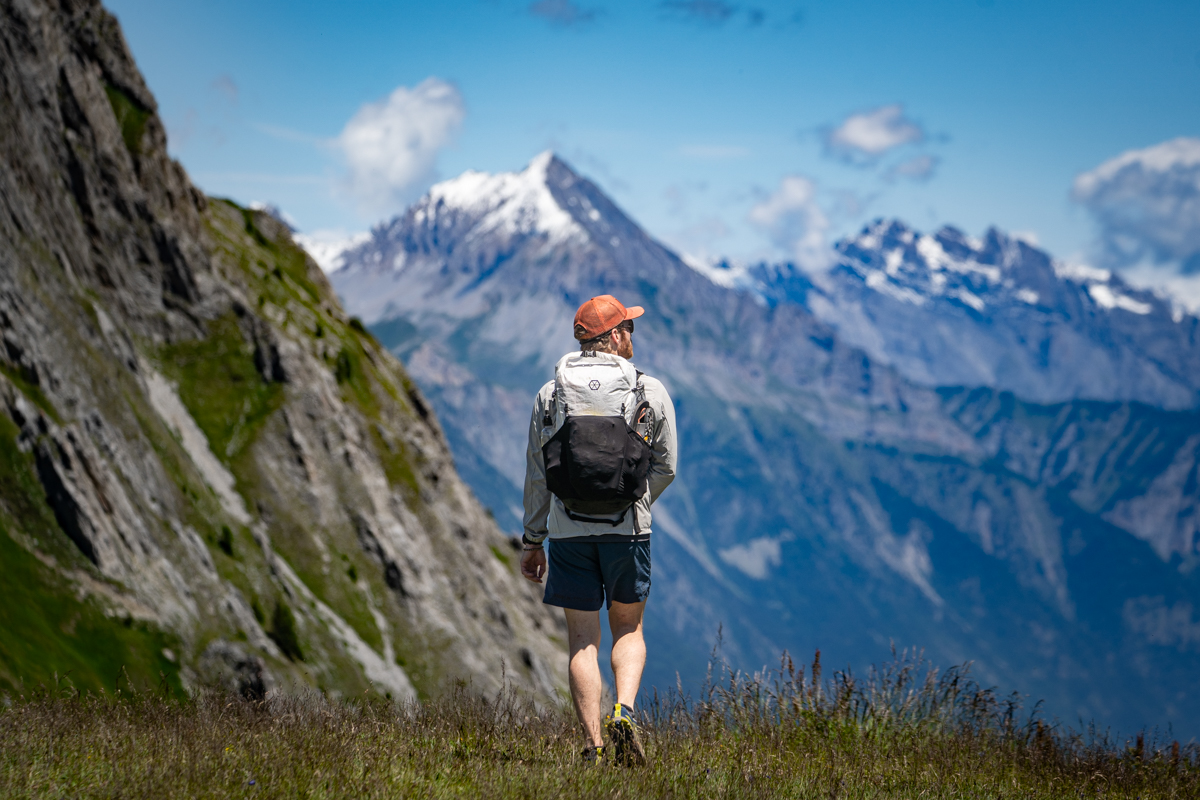
There’s no one-size-fits-all rule for how big your backpack should be. Several factors come into play, including the length of your trips, the seasons you plan to hike in, and whether you’ll be adding extra activities like packrafting or mountaineering. One thing is clear: your pack’s capacity should align with the gear you intend to carry. If you’re using older or bulkier equipment that doesn’t compress well, or like to pack extras, you’ll want a larger, more spacious pack. On the other hand, if your gear kit is lean and lightweight, you’ll have more freedom to choose a smaller, more streamlined pack.
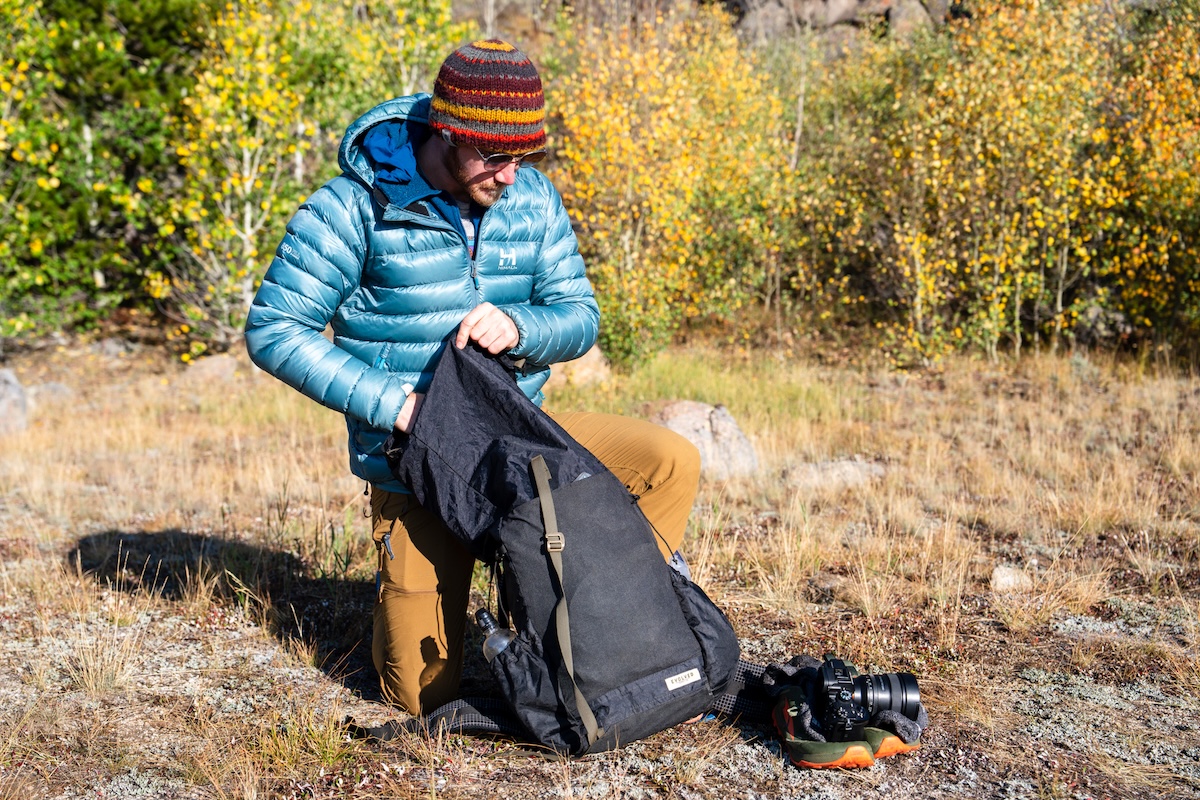
Most backpackers focus on shorter trips, typically lasting one to three nights, and for those adventures, packs between 50 and 70 liters are the go-to choice. Models like the Osprey Atmos AG 50 require you to pack light, bring only the essentials, and rely on compressible gear. Once you get into the 60-liter and up range, you’ve got room for a few extras—perfect for parents or those carrying more gear. Within each size bracket below, you can use these general guidelines to choose based on whether your kit is minimalist or bulkier.
Overnight and/or ultralight gear: 35 to 55 liters
Long weekend (2-3 nights): 50 to 70 liters
Extended trips (over 3 days): 60+ liters
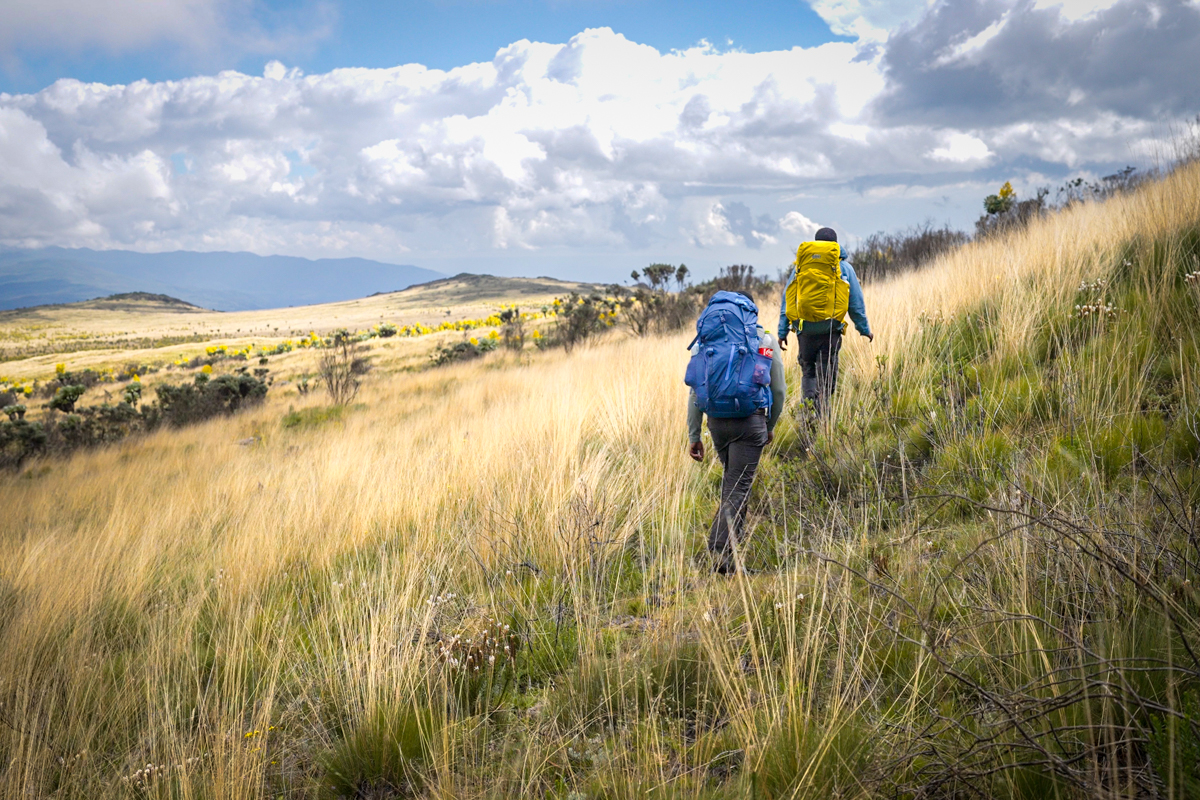
Beyond just fitting your gear in your pack, it’s crucial to estimate how much it will all weigh. Backpackers often talk about their base weight—the weight of all their gear excluding consumables like food and water. Base weights can vary widely, from under 8 pounds on the light end to over 20 pounds on the heavy side. Once you add food, water, and fuel, your pack weight can easily range between 15 and 50 pounds—or even more if you’re not careful. We’re strong advocates for keeping your gear and provisions as light as possible, since lighter loads typically mean more comfort and enjoyment out on the trail.
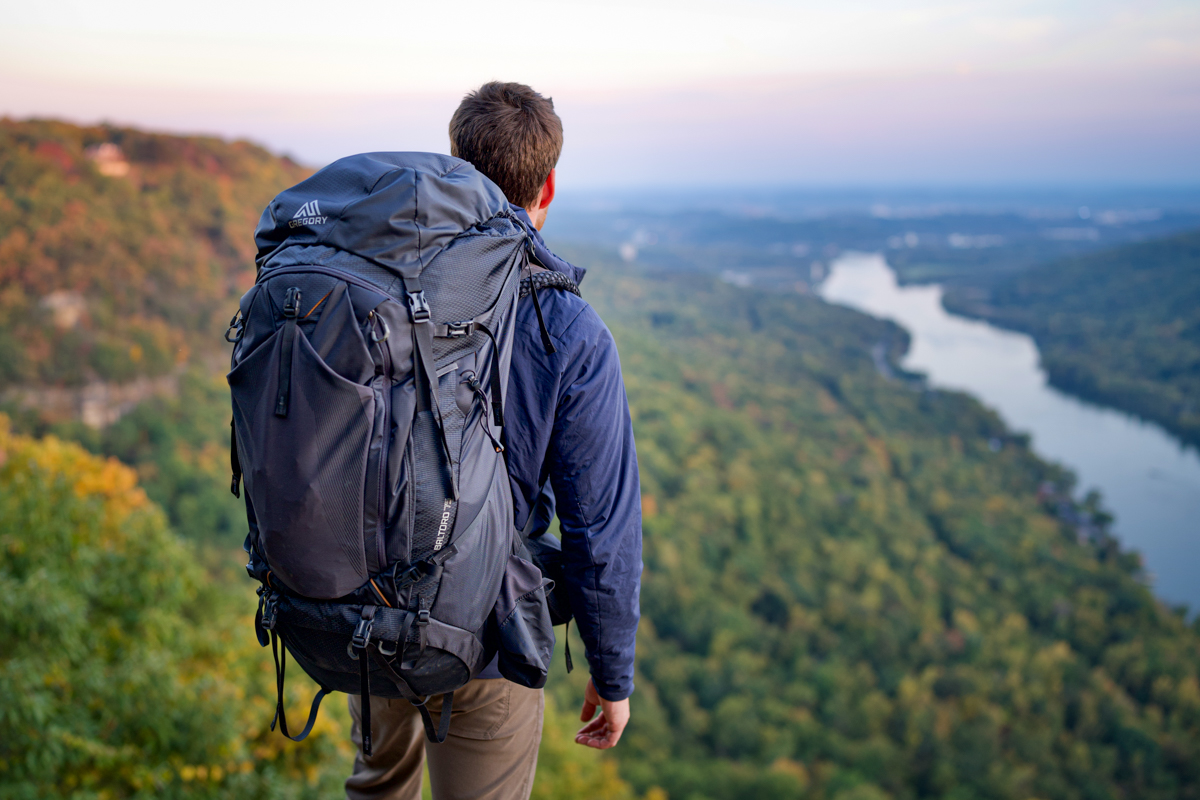
Most backpack manufacturers specify a load limit or range for their packs—on our list, these vary widely, from about 15–30 pounds for the REI Co-op Flash 55 up to 60 pounds for the Osprey Aether 65. Several factors influence a pack’s load capacity, including the materials used and the design of its frame, suspension system, and padding. If you can’t find an official load limit, a good rule of thumb is to consider the pack’s empty weight: generally, a heavier pack features a sturdier frame, tougher fabrics, and thicker padding, enabling it to carry more weight. Of course, this also means a heavier base weight and less nimbleness—fine for casual hikes on well-established trails but less ideal for technical terrain. From our experience, load limits aren’t just recommendations—they’re boundaries you don’t want to push. Overloading a pack often leads to discomfort and can shorten its lifespan.
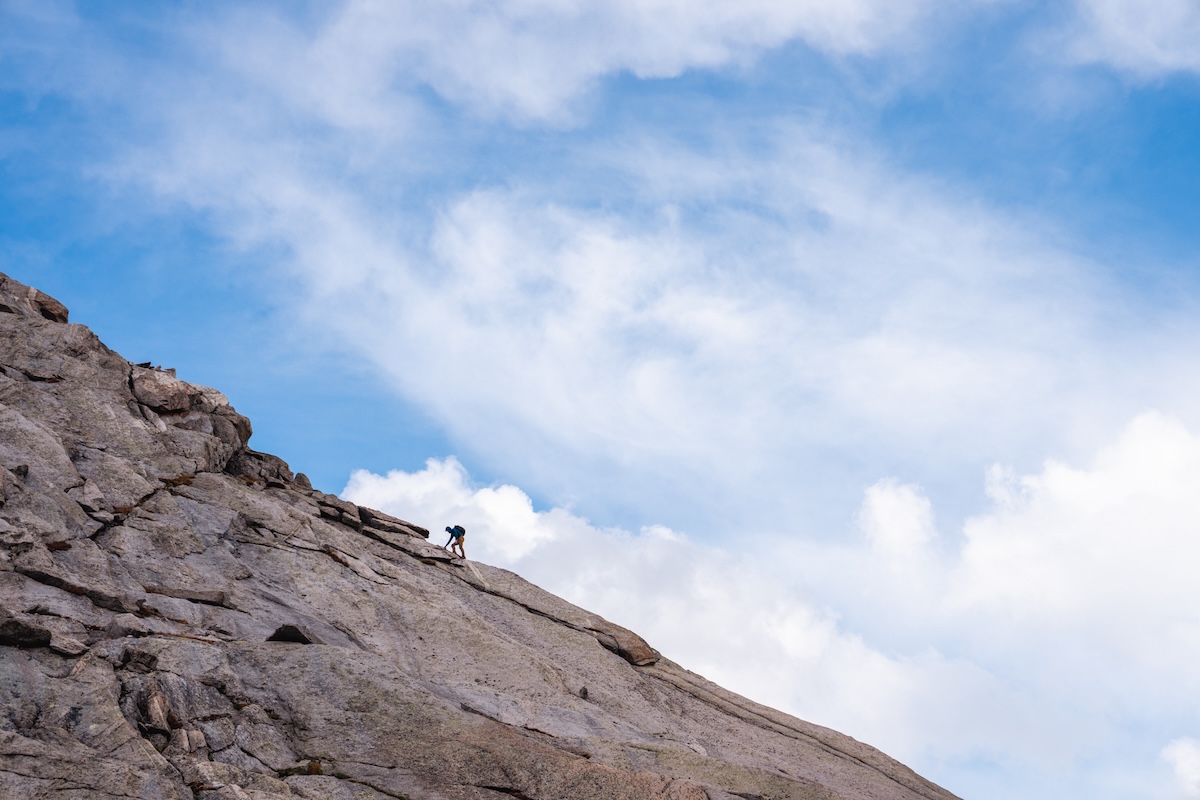
The packs featured in our list span a broad weight range—from the ultra-light 1 pound 5.0 ounces Evolved Supply Co. Ranger up to the more substantial 5 pounds 2.6 ounces Deuter Aircontact Core 65 + 10. When it comes to backpack weight, there are trade-offs: heavier packs add more pounds to your load but typically come with sturdier suspension systems and harnesses that boost comfort and improve load distribution compared to minimalist models. In our experience, backpacks weighing between about 2.5 and 4.5 pounds hit a sweet spot, offering a strong balance of weight and performance for carrying loads up to roughly 35 pounds. If you expect to carry heavier loads regularly, opting for a more robust, heavier pack makes sense.
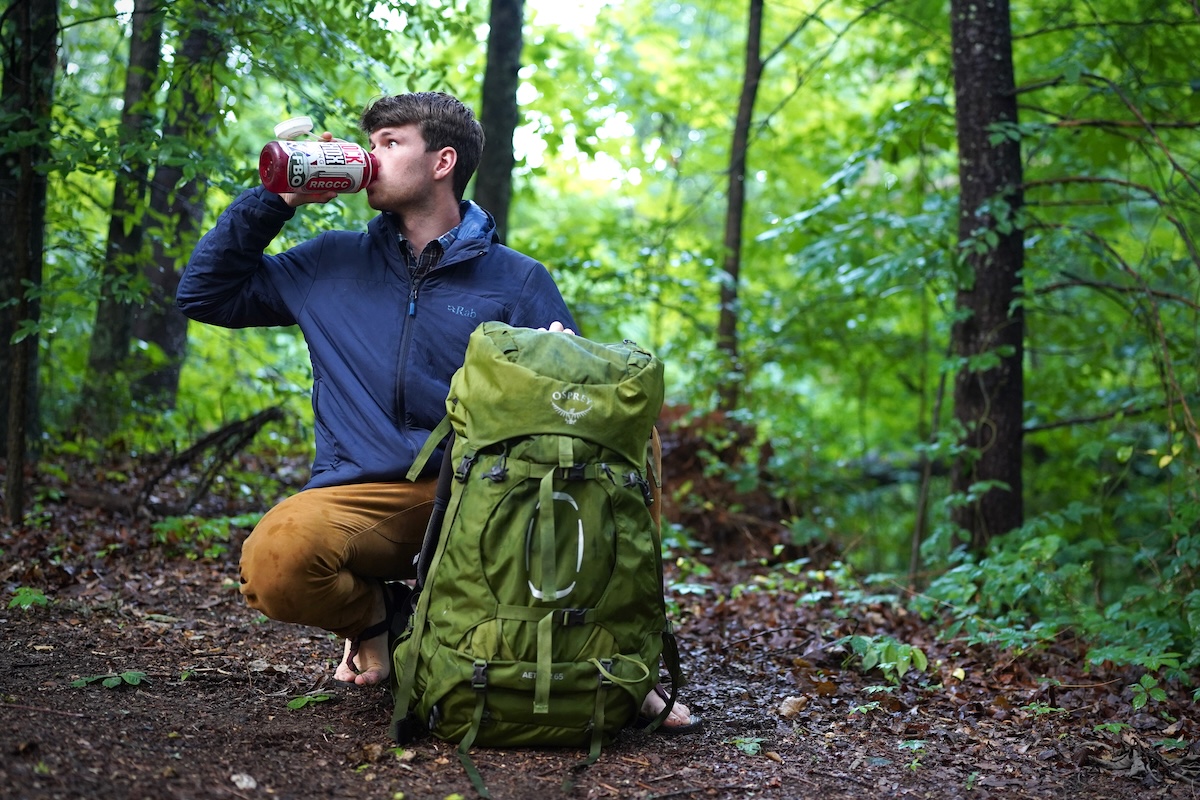
Ultralight Backpacking Packs
Weight is such a priority for many backpackers that an entire category of packs exists focused solely on shedding pounds. Ultralight backpacks typically shave 2 to 3 pounds off the weight of standard models by streamlining organization—most include just a main compartment, one or two hipbelt pockets, and a few external dump pockets. They also rely on thin yet high-end materials like Dyneema and Robic nylon, paired with minimalist suspension systems usually made up of an aluminum stay and foam backpanel. While this approach cuts weight dramatically, it does come at the expense of comfort, especially when carrying loads above 30 pounds. For those dedicated to trimming ounces, the jump from a traditional to an ultralight pack can be game-changing. Just be sure your entire kit is dialed in before heading into the backcountry with an ultralight setup, since overloading one can lead to discomfort or even pack failure on the trail. (For a more detailed look, check out our guide to the best ultralight backpacks).
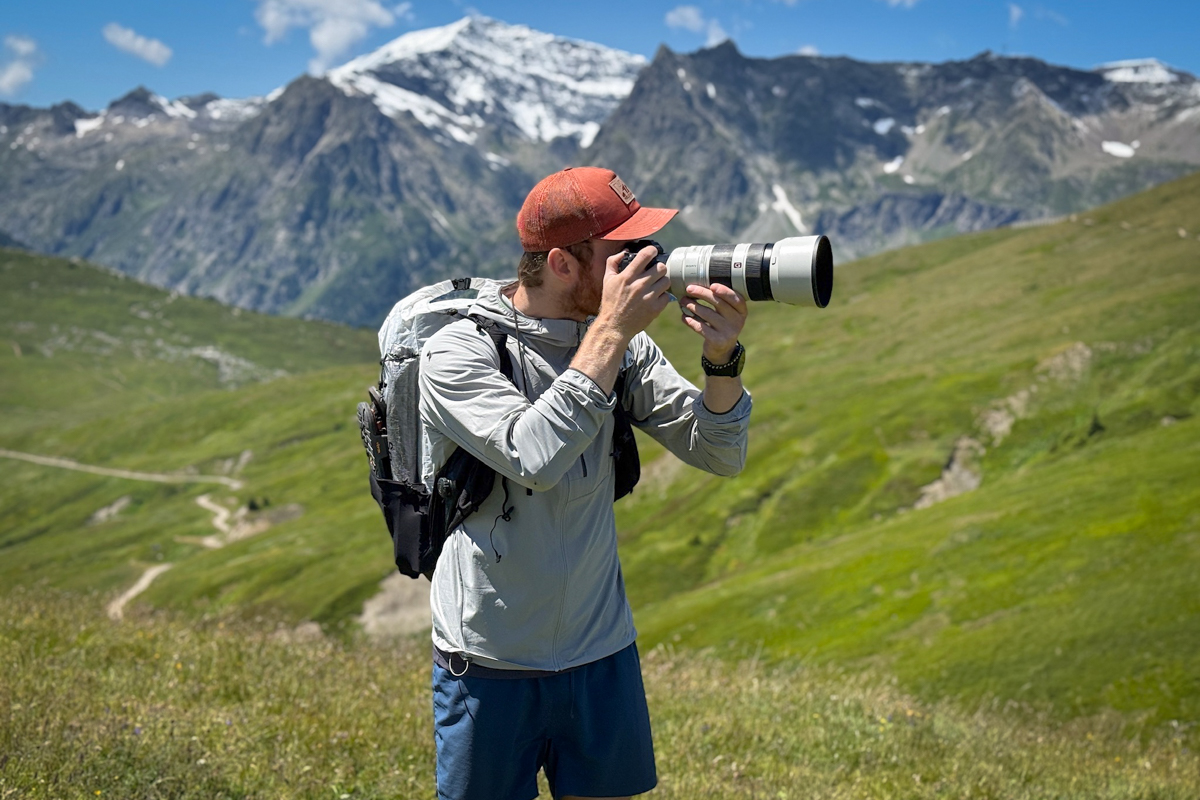
Backpacking backpacks are designed to withstand serious wear and tear—after all, what other gear do you regularly brush against sharp branches, toss on the ground, or sit atop? That said, durability varies widely between packs. One of the best indicators is fabric denier, which measures the thickness of the material. On our list, pack fabrics range from lightweight 100D nylon up to tough 420D, with some key areas reinforced with materials as rugged as 500D. Typically, reinforcements are focused on high-wear spots like the base, front panel, lid, and hipbelt pockets to help extend the life of the pack.
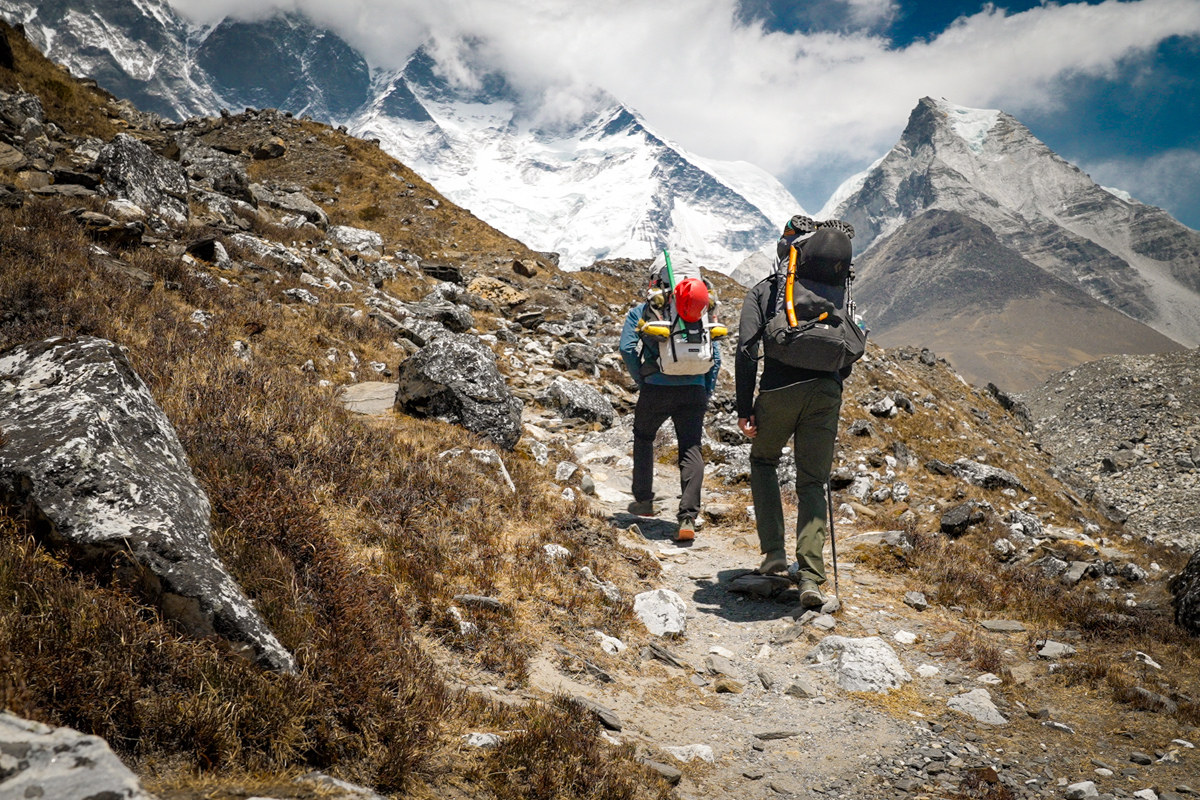
Naturally, the trade-off with thicker fabrics is added weight. That’s why many lightweight and ultralight packs opt for thinner materials, sometimes sacrificing a bit of durability in the process. To strike a balance, premium ultralight backpacks often use high-strength fabrics like Dyneema or Ultra, known for their excellent strength-to-weight ratios—though they come with a higher price tag. That said, fabric thickness and composition shouldn’t automatically dissuade you unless you’re particularly tough on gear, frequently bushwhack, or rely on a pack daily for demanding work like guiding or trail maintenance. Packs like the Osprey Exos (100D) have impressed us with their durability and are more than durable enough for most backpackers.
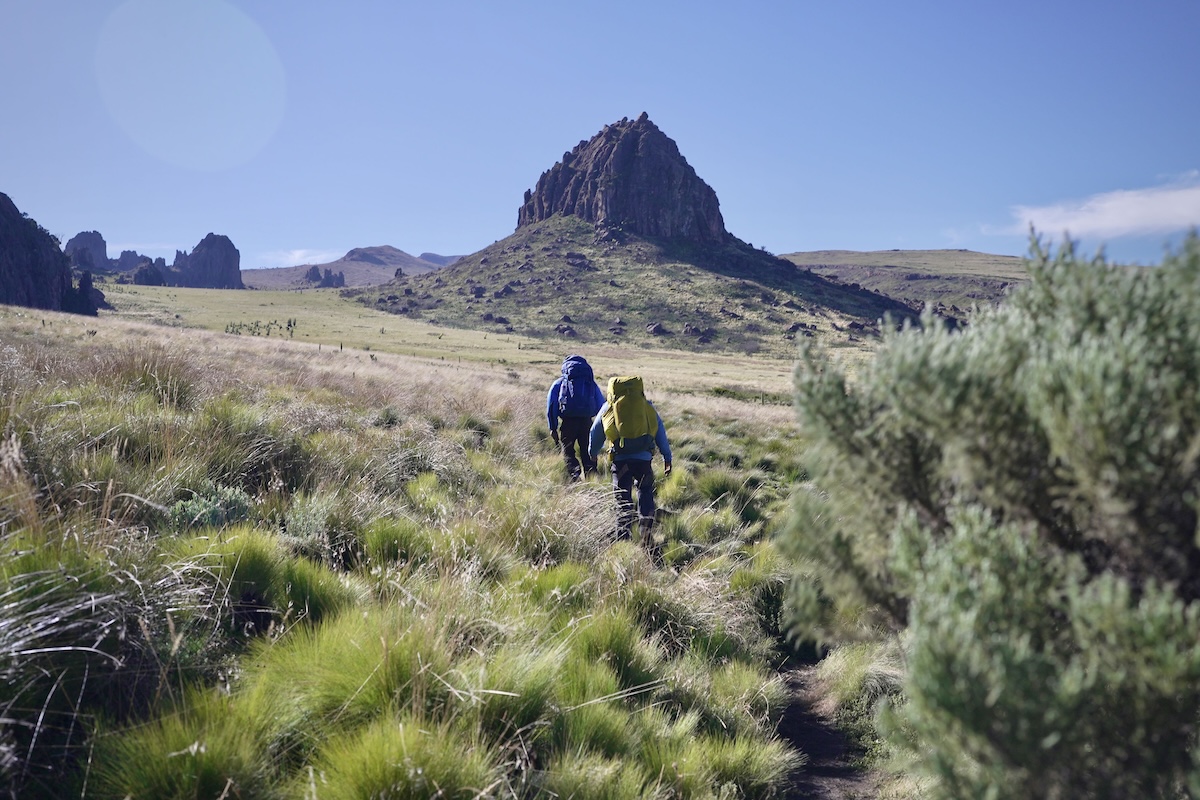
Every overnight backpack includes foam padding in key areas like the shoulder straps and hipbelt—and sometimes in the backpanel—with variations in thickness and quality across models. This padding is designed to boost comfort by distributing weight more evenly and shielding your body from the pack’s edges and hardware. Of course, foam and its fabric covering add weight, so manufacturers constantly balance comfort against pack weight. Typically, heavier packs provide thicker padding for enhanced comfort, while lighter and ultralight models use slimmer padding, which can feel less comfortable—especially when carrying more weight.
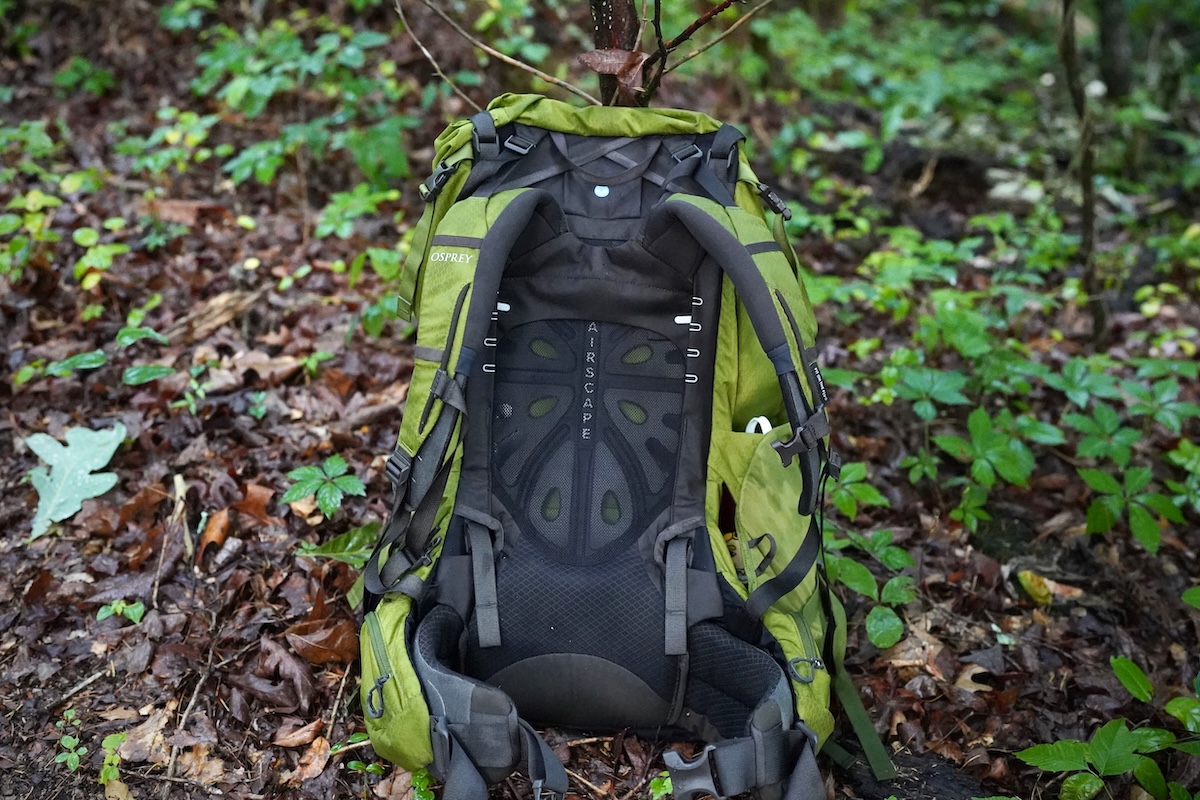
We tend to favor foam padding that leans toward firm support rather than being soft and overly compressible. While plush padding might feel great during initial pack fittings, it often lacks the lasting support needed when carrying heavier loads. Packs like the Gregory Baltoro and Osprey Aether showcase excellent use of high-quality, firm foam. Conversely, many newer models—such as the Osprey Atmos and Exos—replace some padding with suspended mesh, providing similar support with less weight and better airflow. Initially, we were skeptical of this mesh-backed design, but after years of testing various versions, we’re now strong advocates. For loads under 40 pounds, these breathable backpanels deliver comfort on par with their padded counterparts.
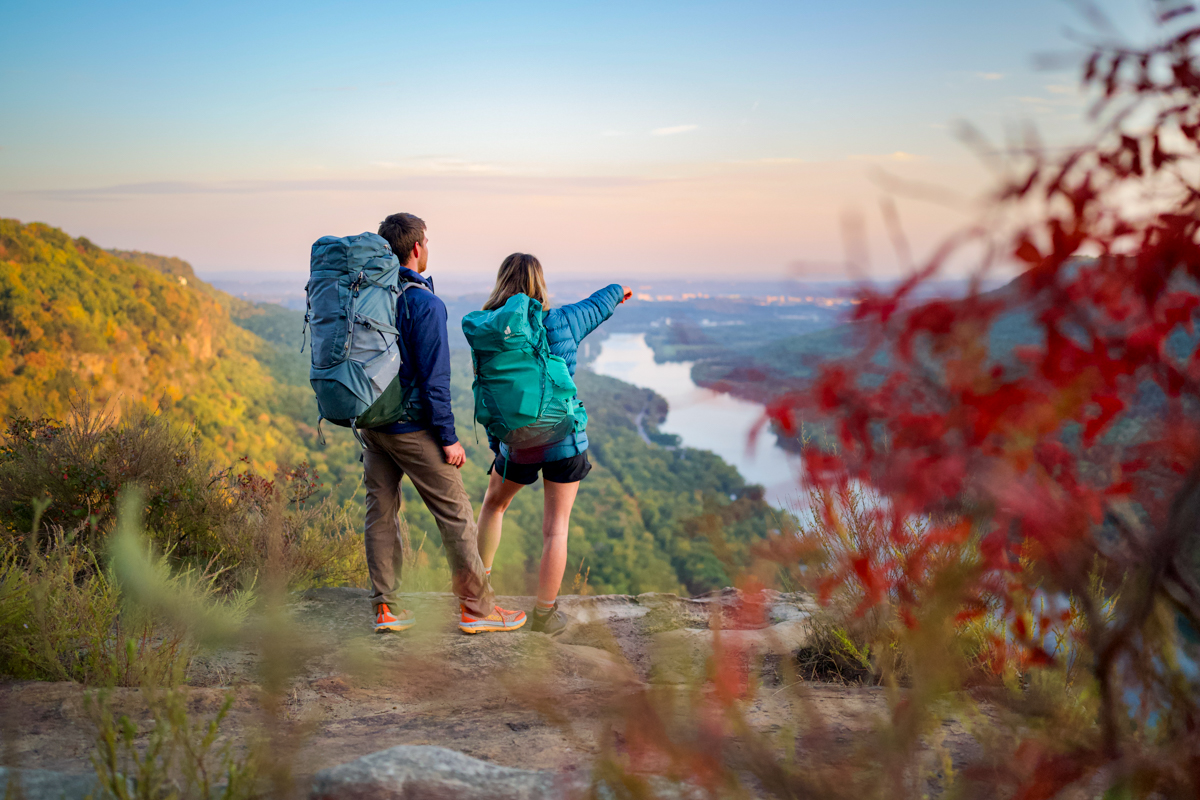
When you’re hauling all your gear on your back, staying organized becomes crucial. Generally, heavier packs provide more storage options. Ultralight models usually stick to one large main compartment and a handful of external pockets, while premium packs include dedicated sleeping bag compartments, multiple access points to the main area, a top lid, and several zippered exterior pockets. That said, more compartments aren't always better—how much organization you need really depends on your personal style and preferences.
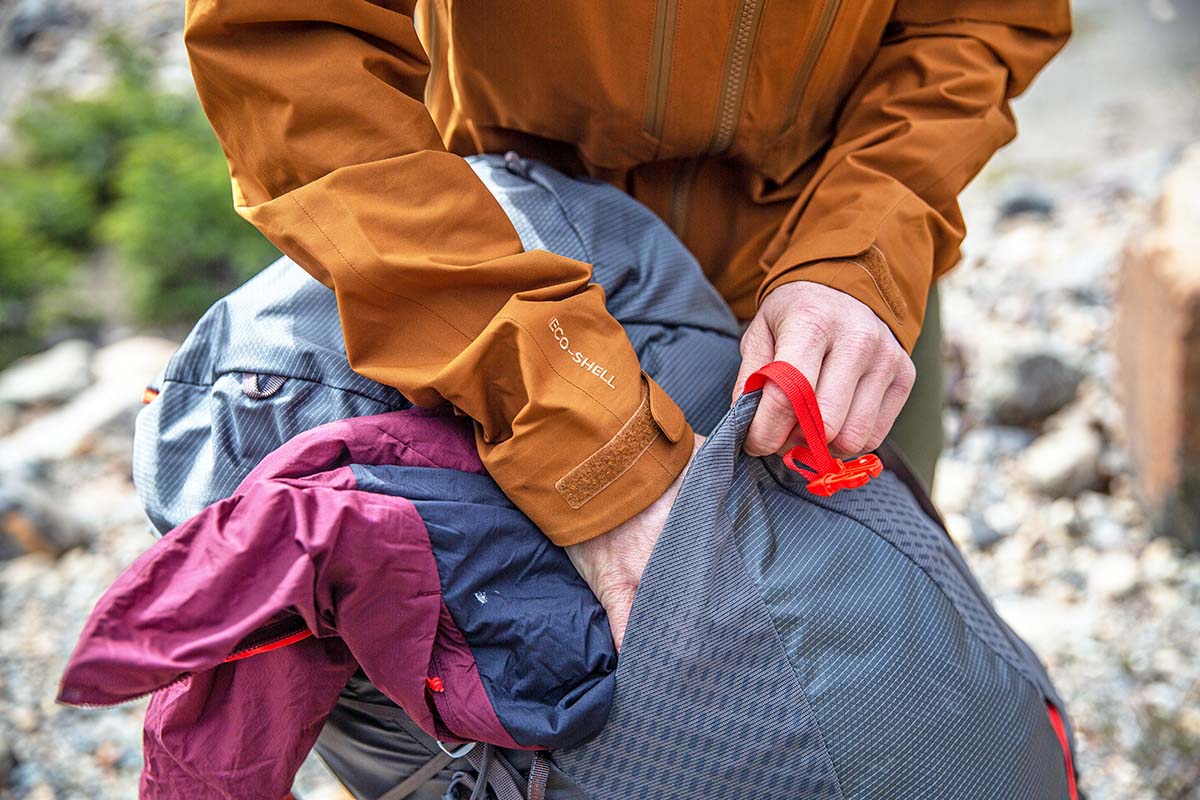
Exterior Pockets
In the comparison chart above, we note how many external pockets each pack offers. Most backpacks come with at least five—typically three dump pockets plus two hipbelt pockets—while many premium models add a few extras. Hipbelt pockets are essential for quick access to items like lip balm, your phone, or Lifesavers (a perfect trail snack). We usually stash a layer or two in the front dump pocket, while side dump pockets work great for water bottles or trekking poles. Many packs also include a top lid with one or two zippered compartments, ideal for small essentials like a headlamp or snacks, and often removable for easy carrying around camp. That said, it’s worth remembering that not every needs a ton of pockets—five or six pockets hit the sweet spot for us, while too many can lead to losing track of your gear.
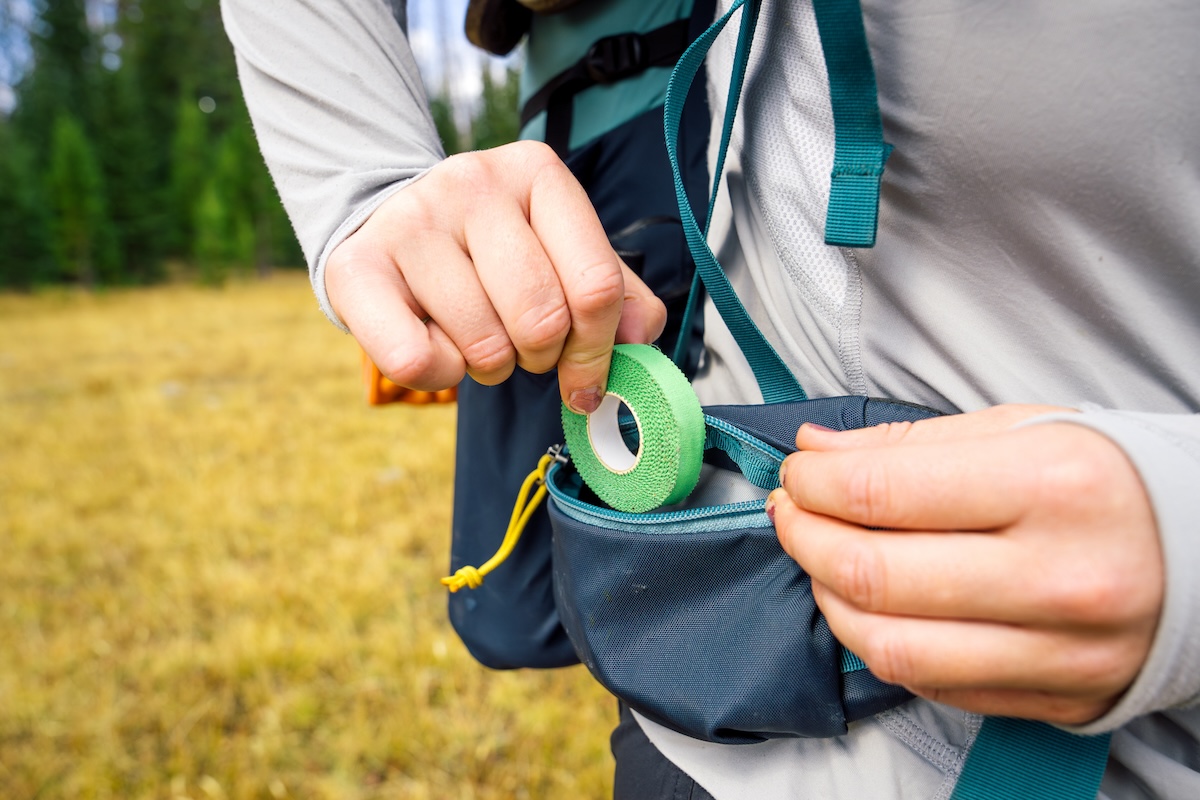
Main Compartment Access
Almost all backpacking packs feature a top opening secured with a cinch cord or roll-top closure, known as a top-loader. Having additional access points—like side zippers or a J- or U-shaped front opening—can be a game-changer, saving you from digging through a carefully packed bag to locate a single item. While these extra zippers add some weight, they’re usually worth the trade-off. Packs like the Gregory Baltoro and Osprey Aether offer U-shaped openings so wide that loading and unloading feels more like using a travel suitcase than a traditional pack.
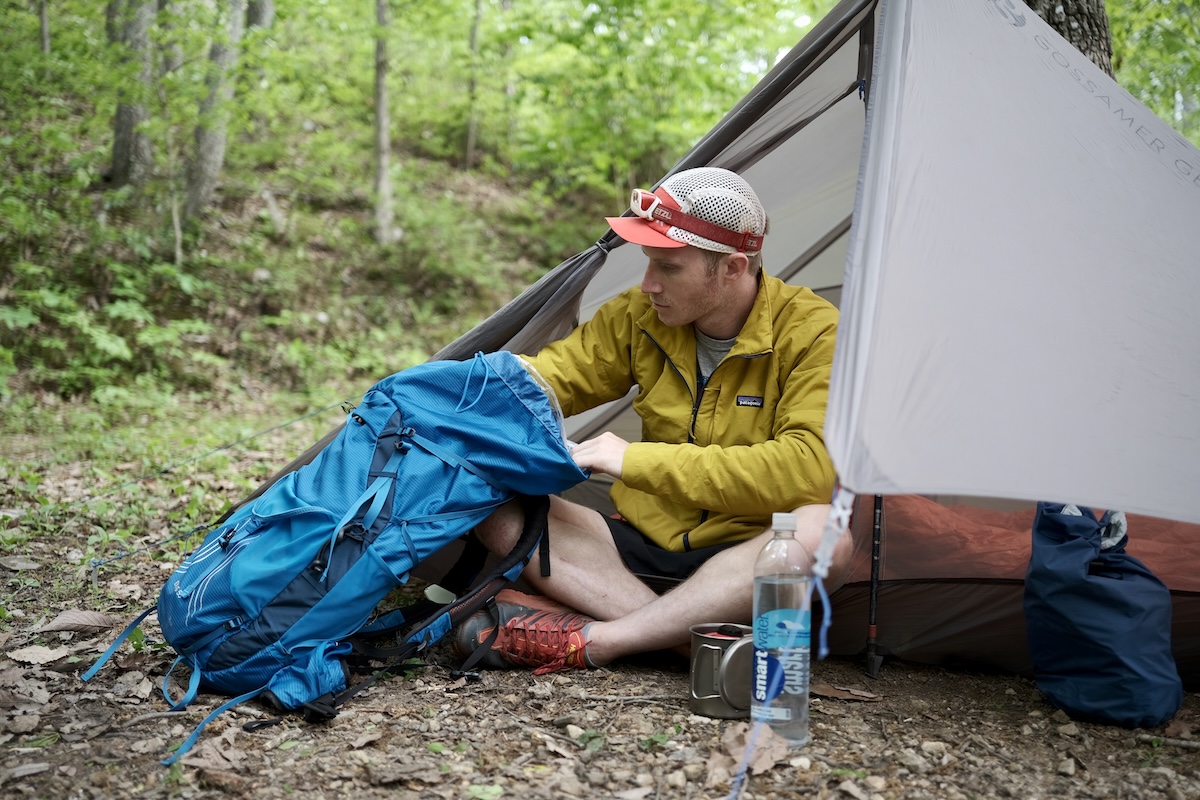
Sleeping Bag Compartment
Feature-packed backpacks often come with a dedicated sleeping bag compartment, usually located beneath the main storage area. This pocket typically has a zipper closure, is roomy enough for most sleeping bags—including bulky ones—and includes external compression straps to minimize unused space. Some models even offer a zipper that connects the sleeping bag compartment to the main pack, allowing for more flexible packing. However, these features add extra weight and bulk, making for a less streamlined carry. Personally, we prefer packs without a dedicated sleeping bag compartment, giving us the freedom to stash our sleeping bag in a compression sack and toss it in alongside our tent at the bottom of the pack. For a detailed look at packing strategies, check out our article on How to Pack a Backpack.
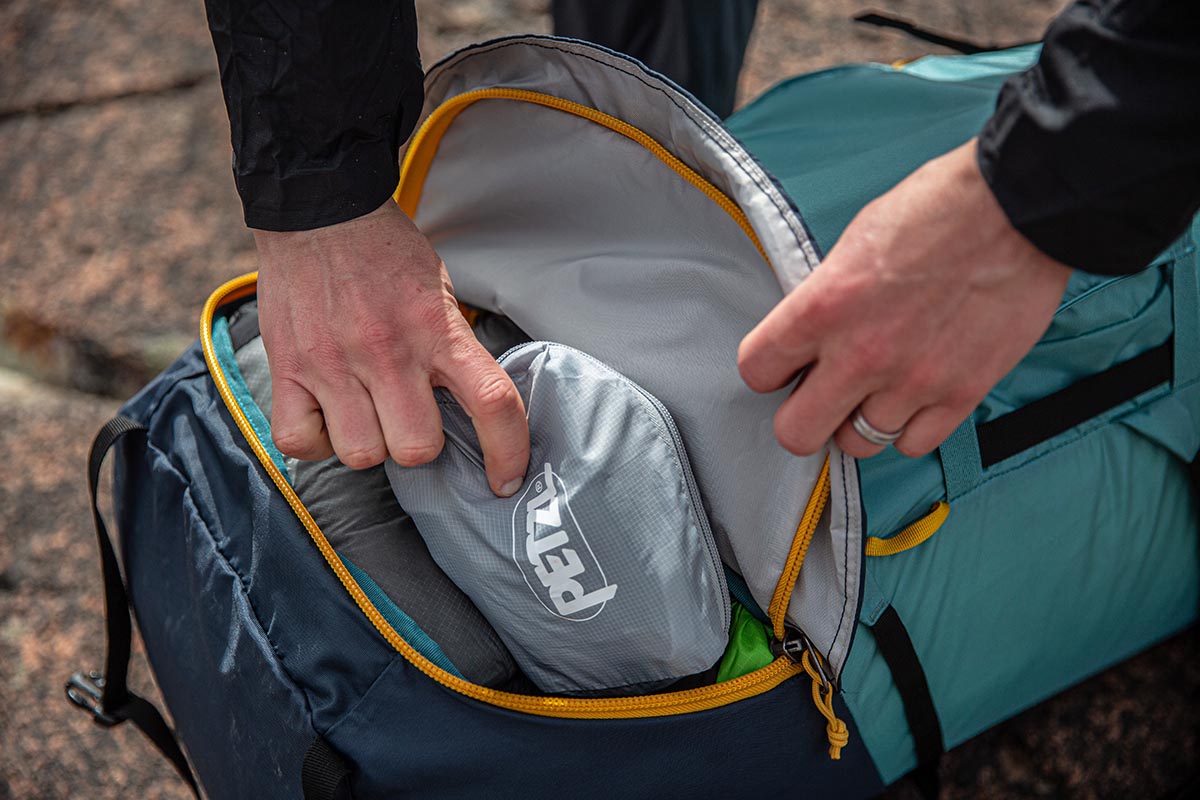
Water Reservoir (Bladder) Compatibility
Water reservoirs have become our—and many hikers’—go-to method for staying hydrated on the trail thanks to their hands-free convenience. That’s why nearly all backpacking packs include features designed to accommodate hydration reservoirs. Look for a dedicated sleeve or hanging clip, an exit port for the drinking tube, and straps or clips to secure the tube along the shoulder strap. One tip: pack your hydration bladder first so it can hang freely along the backpanel. But if you happen to forget and pack it last, no worries—you can simply rest it on top of your gear. To keep the water from sloshing around, flip the reservoir upside down and squeeze out any air before sealing it up.
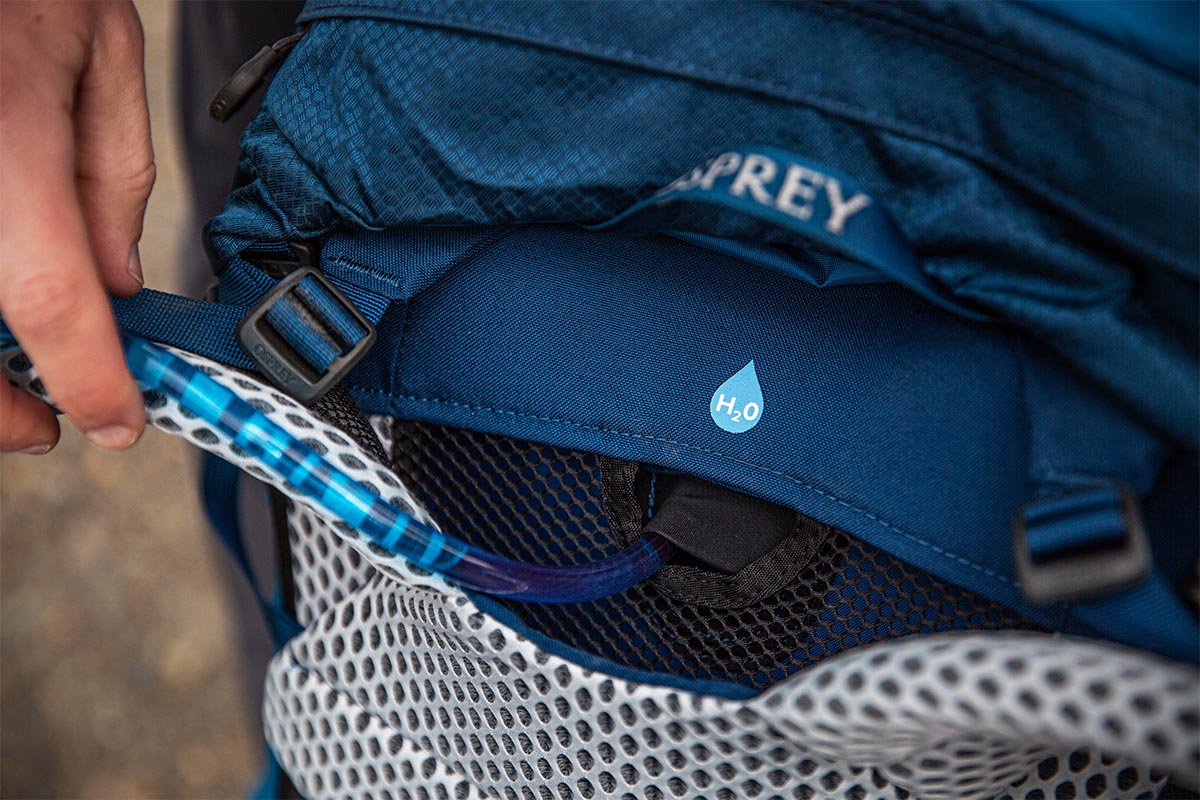
Compression Straps
Compression straps help stabilize your load by tightening the pack from front to back, pulling everything close to your body for better balance on the trail. When choosing a pack, look for side compression straps at both the top and bottom—they’re essential for keeping your gear secure and balanced, so give them a good cinch every time you strap in. These straps also come in handy for attaching taller items like tent poles along the pack’s sides. We especially like systems like REI’s Packmod on the Flash 55, which lets you reposition or remove straps using daisy chains for a customized fit. While some straps use simple plastic cinches, we prefer buckle closures for their ease—especially when securing bulkier gear like a sleeping pad.
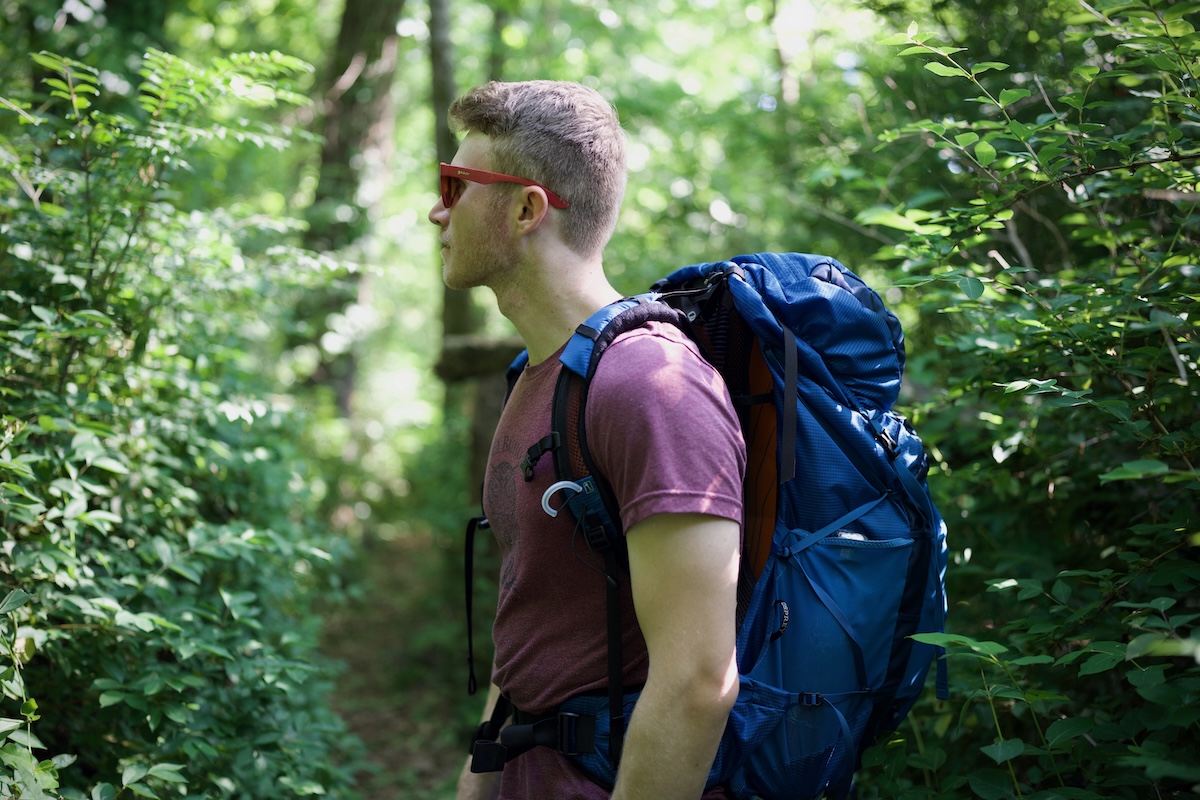
Ventilation on the backpanel and hipbelt is a major factor for many, especially if you tend to run warm or hike in hot weather. But finding an internal framed pack that breathes well can be tricky since packs are designed to hug your body and move with you. Most feature offset foam and mesh panels that do an okay job at encouraging airflow, but you’ll probably still end up with sweat marks where the foam touches your back. On the flip side, packs with fully suspended mesh backpanels and hipbelts—like Osprey’s Anti-Gravity system on packs like the Atmos—cradle your body while providing excellent ventilation. We’re big fans of this design for anyone prioritizing airflow, though it does reduce main compartment space and isn’t ideal for carrying as much weight.
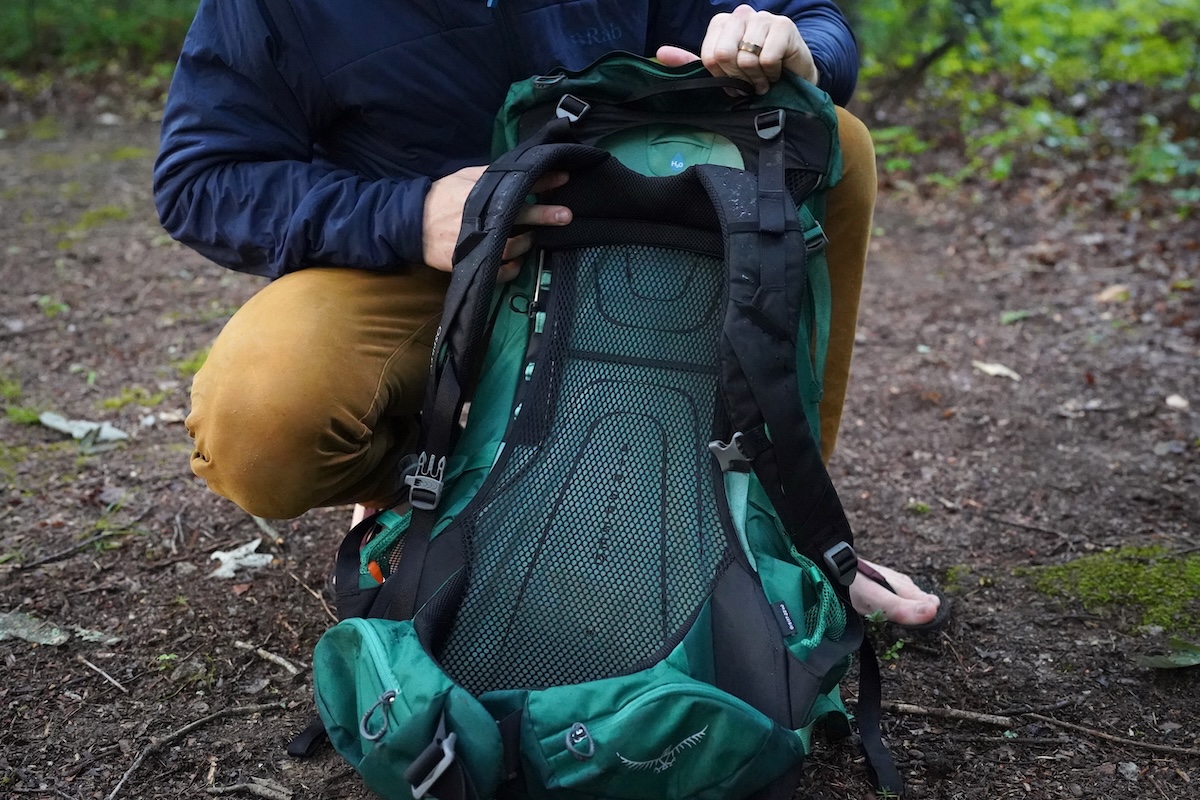
Many of the items we carry in our packs—like cameras, phones, and down sleeping bags—are sensitive to moisture, so water protection is a top priority. Fortunately, most backpacks provide decent water resistance thanks to hard-face nylon and durable water repellent (DWR) coatings, but don’t expect them to hold up against prolonged rain. For true waterproofing, there are packs made from materials like Dyneema or Ultra fabrics. For example, we’ve relied on the 100% Dyneema Hyperlite Windrider as a dry bag (check out our in-depth review) and it performed flawlessly.
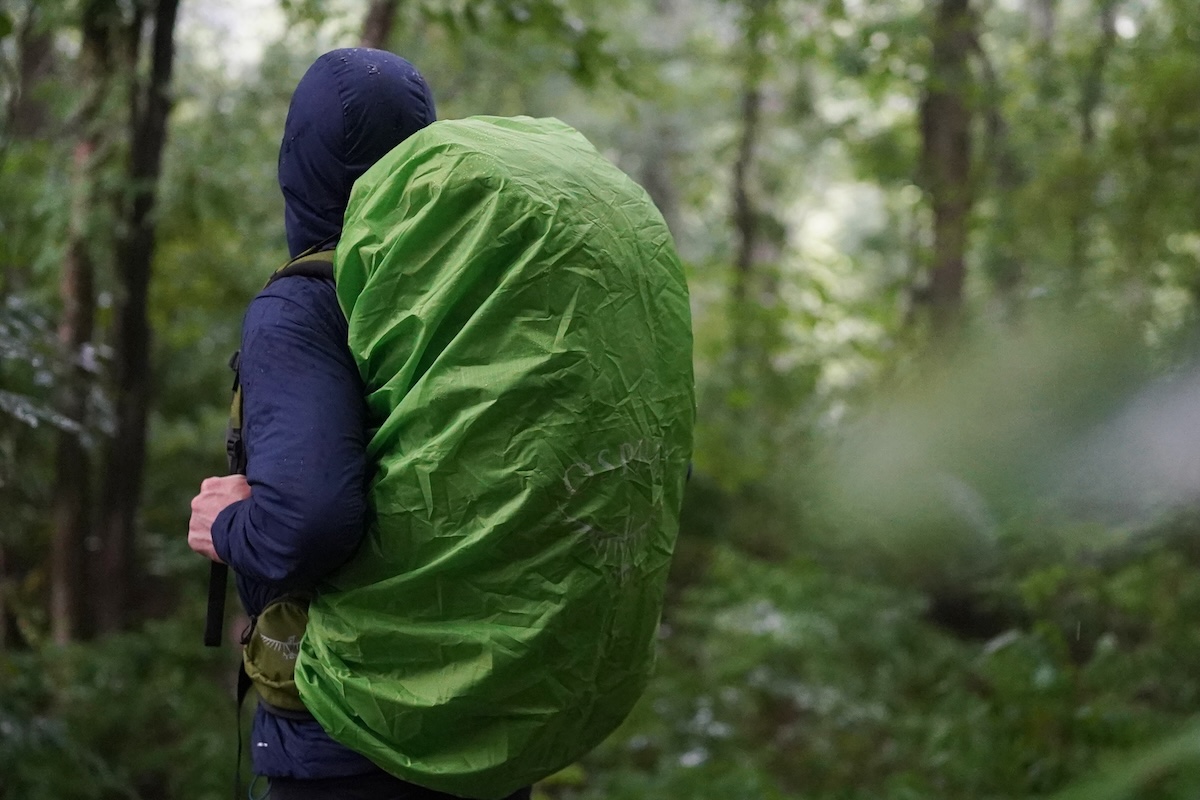
If your pack isn’t fully waterproof—which is often the case—it’s smart to take extra steps to keep your gear dry. Some backpacks come with a built-in rain cover that tucks away inside the pack, like the Gregory Baltoro. Alternatively, you can buy a rain cover separately; for example, REI Co-op's Duck's Back Raincover does the job well. Just remember that these covers aren’t foolproof and can be tricky to rely on during windy weather.
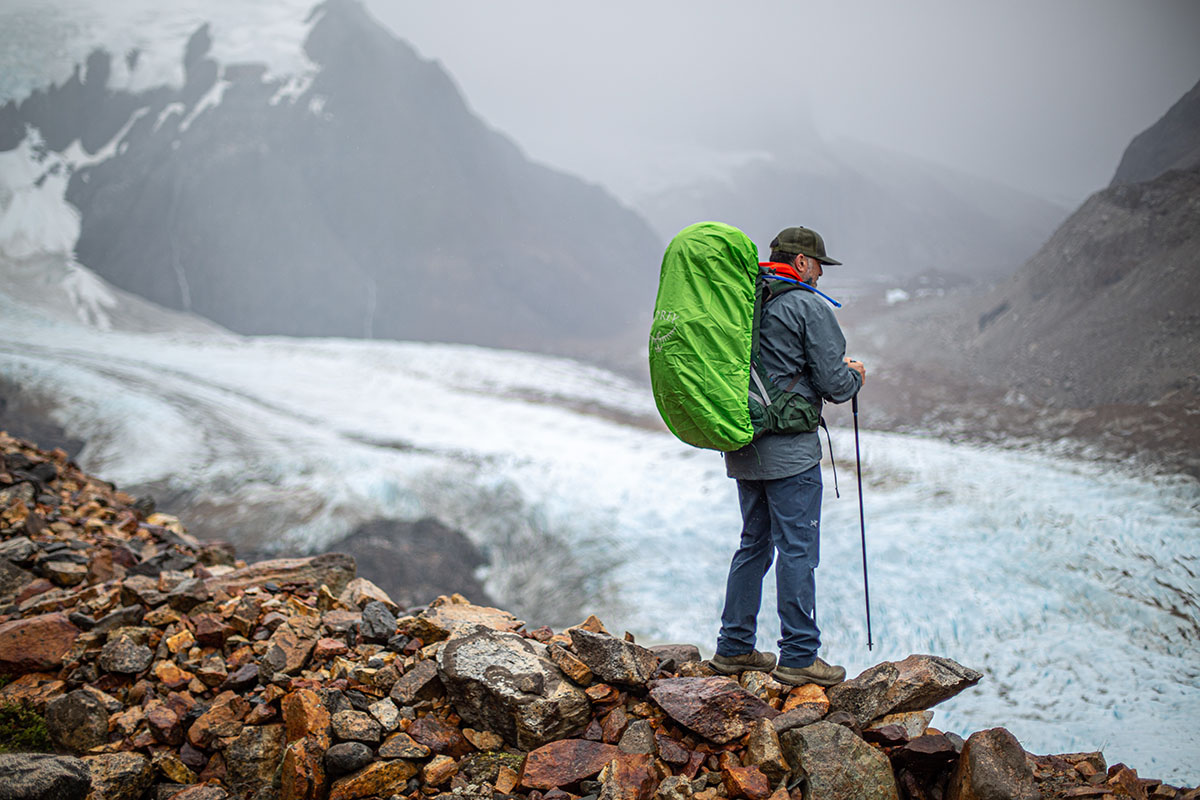
Another effective way to keep your gear dry is by protecting it from the inside out—either by lining your entire pack with a waterproof liner or using a mix of waterproof stuff sacks and dry bags. In a pinch, even heavy-duty garbage bags can do the trick; for example, when guiding in British Columbia’s rainy Coast Mountains, we used a trash compactor bag to line our pack and had zero leaks. This approach works especially well with packs that have a large, open main compartment, which is common among many ultralight models.
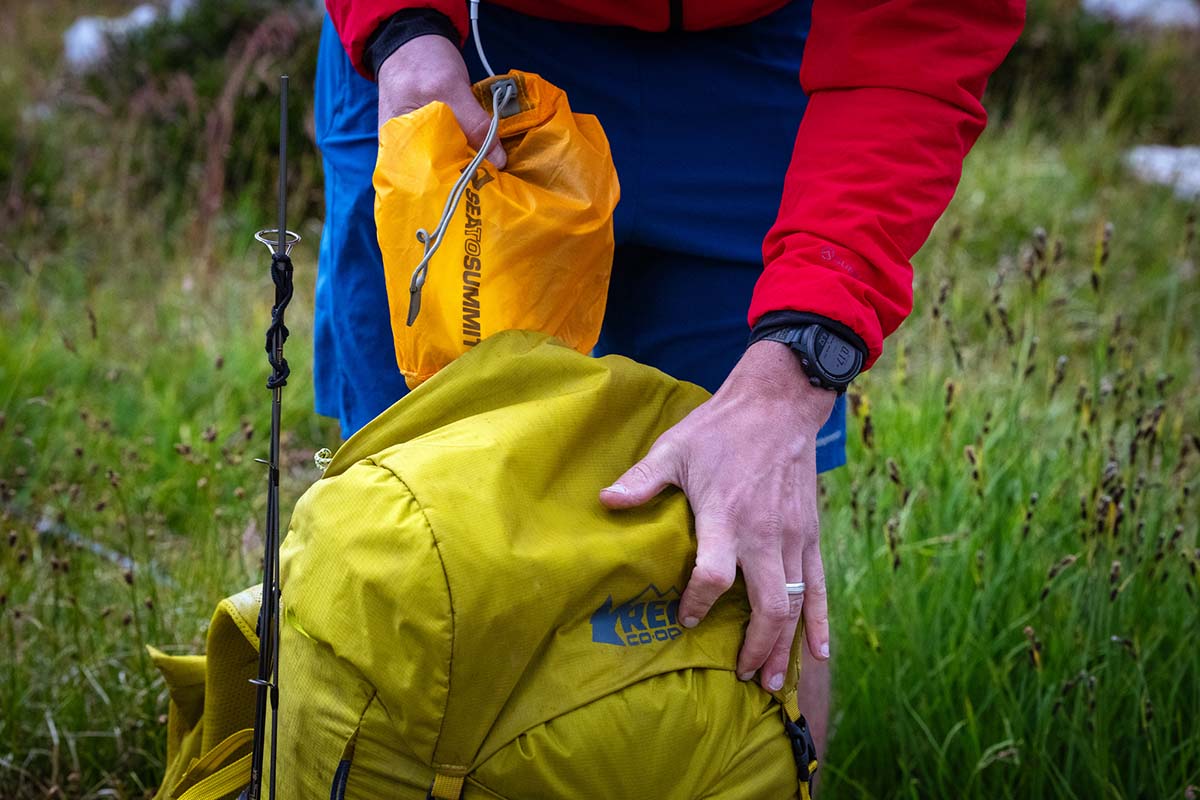
Two of the most popular waterproof pack liners are Nylofume bags or polyethylene bags. Both are great alternatives to trash bags or rain covers and can also serve as odor barriers when tied off securely at the top. For reference, one Nylofume liner kept a tester's gear safe and dry for an entire three-month thru-hike of the Appalachian Trail. These liners are relatively cheap, way stronger than they seem, and add negligible weight to your pack.
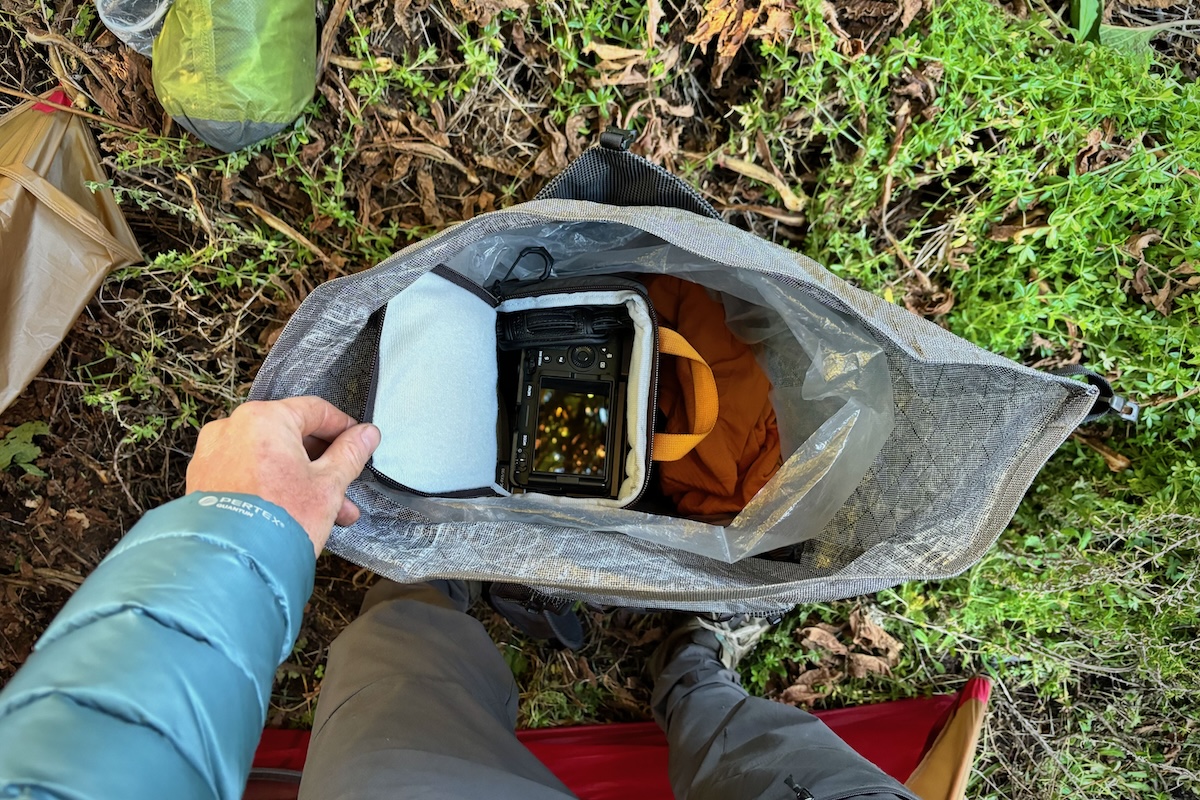
One of the biggest contributors to a great time on the trail is making sure your pack fits right. Most backpacks come in both men’s and women’s versions (for a detailed look at women’s packs, check out our article on the best women's backpacking backpacks) and typically offer one to three size options. These sizes mainly differ by torso and hip measurements, with torso length being the key factor. While hipbelts usually offer plenty of adjustability, if your hip-to-torso ratio is unusual, choosing a pack with a customizable hipbelt can make a big difference. Once you’ve settled on the right size, there’s still plenty of room to fine-tune the fit—most packs let you adjust torso length significantly and also the height of the hipbelt. For a complete guide on getting your pack dialed in, see our Backpack Fit and Sizing Guide.
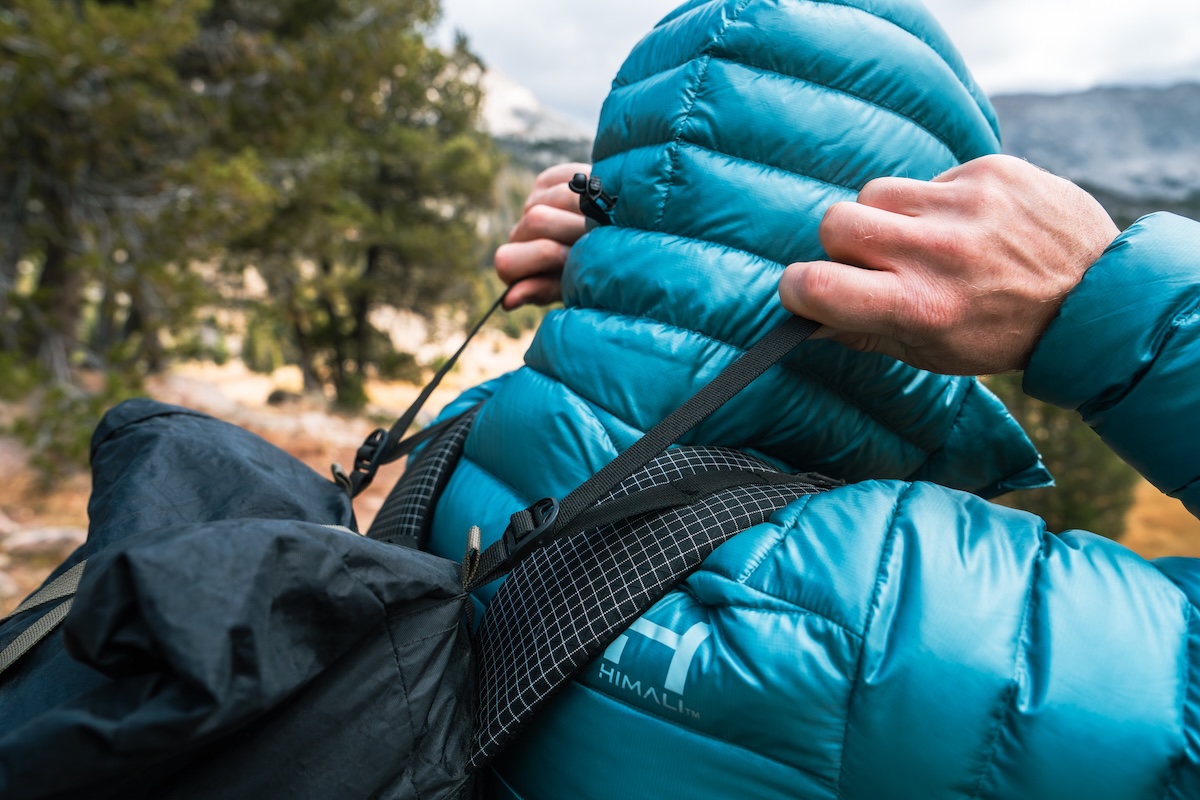
Seriously analyzing our environmental impact has never been more important, and it’s encouraging to see gear brands making strides toward sustainability. The use of recycled fabrics has grown significantly in recent years, with companies like Osprey, Gregory, and Deuter leading the charge. We’re also seeing a surge in PFAS-free durable water-repellent (DWR) coatings on backpacks—these eliminate some or all per- and polyfluoroalkyl substances, the so-called “forever chemicals” linked to environmental and health concerns. As more states move to ban PFAS-containing products, the outdoor industry is actively pursuing safer, eco-friendly water- and stain-resistant alternatives (you can read more about Patagonia’s take on the issue here). Overall, it’s an exciting moment for sustainability, and it’s great to see this progress reflected in today’s backpacking backpacks.
Back to Our Top Backpacking Pack Picks Back to Our Backpacking Pack Comparison Table